Sparrows are one of the most widely distributed and abundant bird species in the world. They can be found in almost every habitat, from cities and suburbs to deserts and mountains.
Despite their ubiquity, their incredible diversity of behaviors and plumage patterns can make them difficult to identify.
This article will explore the various species of sparrows, their importance in the environment, and the threats they face.
1. House Sparrow
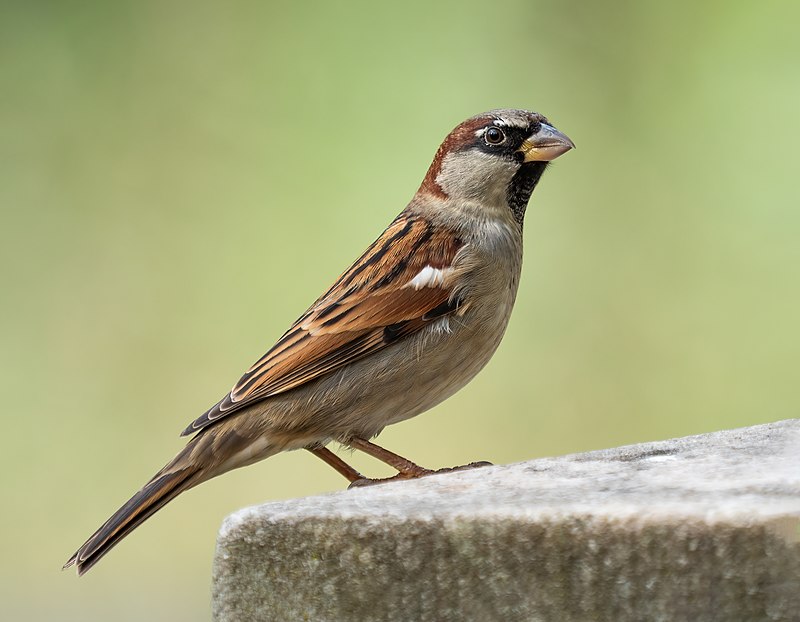
The house sparrow is a small bird of the Passeridae family. It has an average length of 16 cm and weighs 24-39.5 gm.
Females have dull brown and grey plumage, whereas males are brighter, with black, white and brown markings on their wings and back feathers.
This species is one among 25 different kinds in its genus Passer .These birds are found all around the world mainly near human dwellings where they feed off food scraps from garbage bins or gardens etc..
They also make nests close to houses which makes them even more visible to people living nearby.
House sparrows can be seen hopping around yards looking for food during daytime hours but usually hide in colonies at night time.Scientific classification:
| Kingdom | Animalia |
| Phylum | Chordata |
| Class | Aves |
| Order | Passeriformes |
| Family | Passeridae |
| Genus | Passer |
| Species | P. domesticus |
2. Song Sparrow
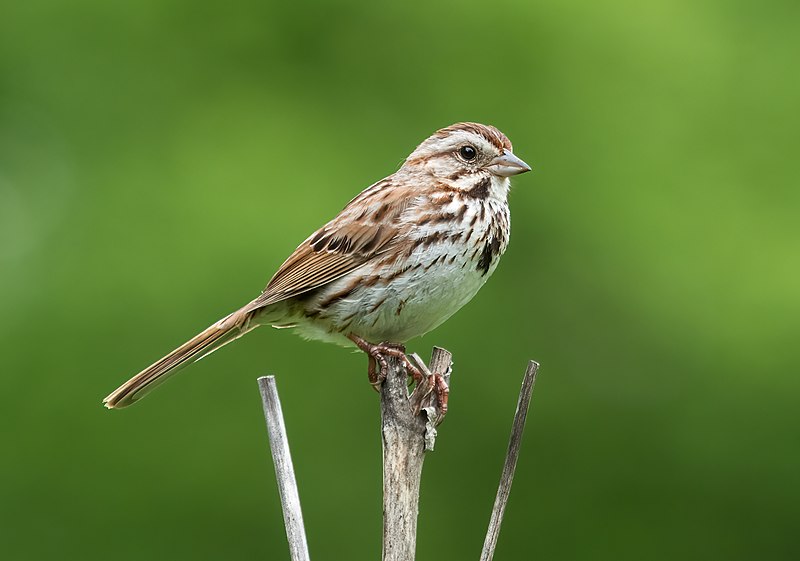
The Song Sparrow (Melospiza melodia) is a small, yet abundant bird found in North America.
They have brown upperparts with dark streaks and are white underneath, complete with a distinct dark brown spot on the breast.
Their cap is also brown and long roughed feathers can be seen sprouting from their neck area.
This sparrow species is highly variable and adaptable to many different environments including dry brush land, wetlands or open fields.
It has been noted that adult song sparrows will sing even during winter months when other birds remain quiet.
These energetic little animals make for great backyard companions as they flit about singing their lovely melodies.Scientific classification:
| Kingdom | Animalia |
| Phylum | Chordata |
| Class | Aves |
| Order | Passeriformes |
| Family | Passerellidae |
| Genus | Melospiza |
| Species | M. melodia |
3. Eurasian Tree Sparrow
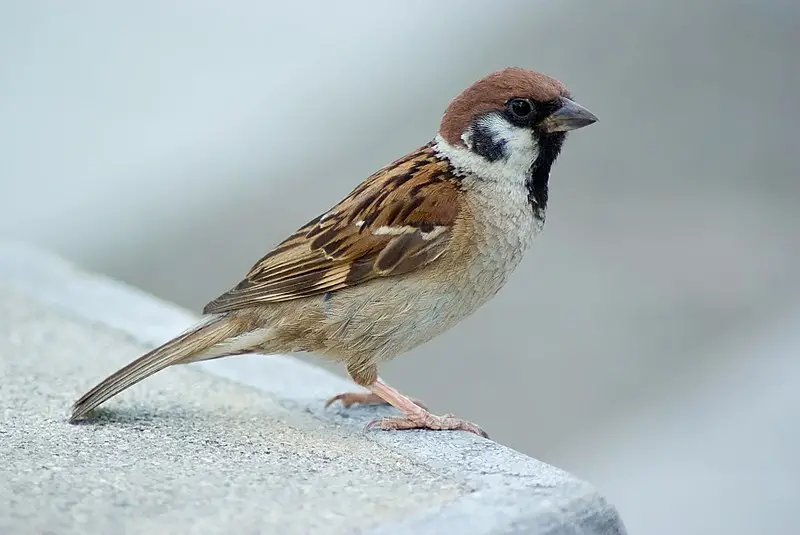
The Eurasian tree sparrow is a passerine bird in the sparrow family, easily recognizable by its chestnut crown and nape as well as black cheek patches.
Both males and females have similar plumage, while young birds appear duller than adults.
This species has an extensive range covering most of temperate Eurasia and Southeast Asia where it goes by the name ‘tree sparrow’.
It has also been introduced to other countries outside these regions. The bird feeds on grains, fruits and insects with preference for open areas near human settlements such as farmland or villages.
They are social creatures that can be found in small flocks all year round but do not migrate long distances like some species of their kind.Scientific classification:
| Kingdom | Animalia |
| Phylum | Chordata |
| Class | Aves |
| Order | Passeriformes |
| Family | Passeridae |
| Genus | Passer |
| Species | P. montanus |
Also Featured In: Hong Kong Birds You Need to See, Urban Birds of Hong Kong
4. American Tree Sparrow
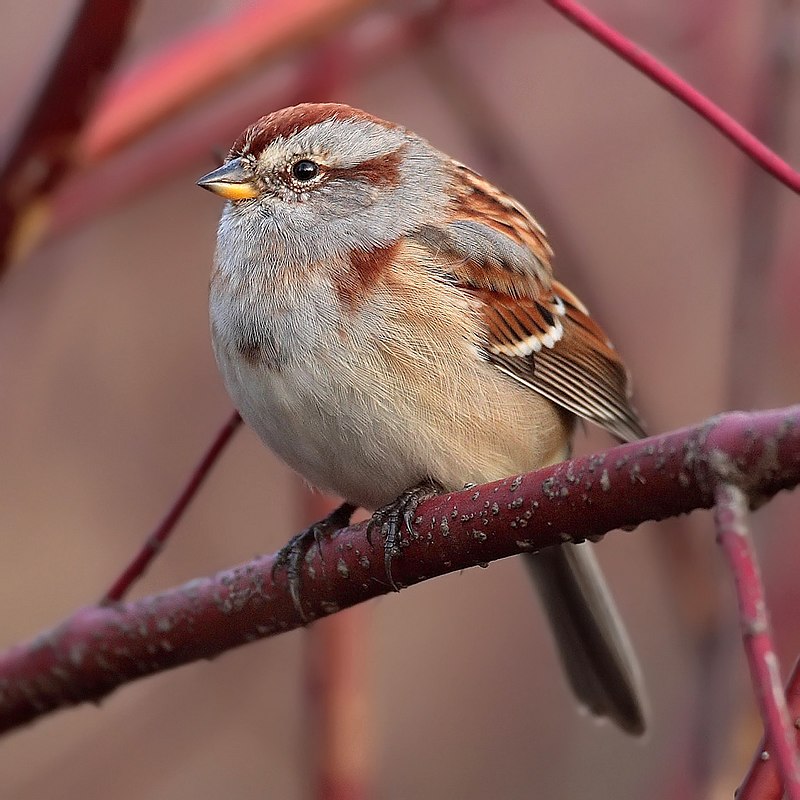
The American tree sparrow, also known as the winter sparrow, is a medium-sized New World bird. It has an attractive rusty cap and grey underparts with a small dark spot on its chest.
Its back is rust colored and striped with lighter shades of brown while its wings have various shades of browns.
These birds are usually found in open areas such as grasslands or marshland during spring migration and can form large flocks when seeking food sources like seeds, insects or berries.
They nest in shrubs or trees near water sources but rarely do so far away from human settlements due to their dependence on supplementary foods provided by humans.
The American Tree Sparrow is a delightful sight for any nature enthusiast.Scientific classification:
| Kingdom | Animalia |
| Phylum | Chordata |
| Class | Aves |
| Order | Passeriformes |
| Family | Passerellidae |
| Genus | Spizelloides Slager & Klicka, 2014 |
| Species | S. arborea |
Also Featured In: Most Common Winter Birds, Birds Commonly Found in New York
5. White-Crowned Sparrow
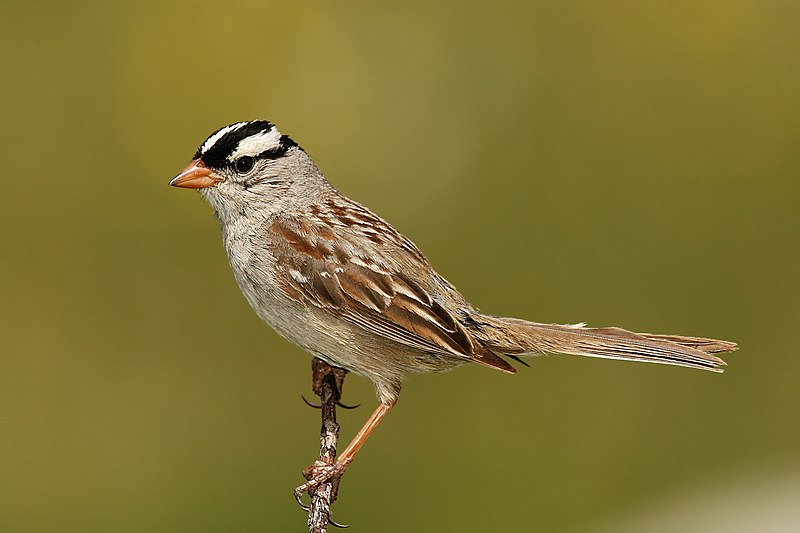
The White-crowned Sparrow is a species of passerine bird native to North America. It has a grey face and black and white streaking on its upper head, making it easy to identify.
This sparrow usually breeds in brushy areas located in the taiga, tundra, Rocky Mountains or Pacific coast regions of North America.
During winter months these birds migrate southward as far as Mexico and California where they can be found living amongst chaparral shrubbery or low bushes near open fields with plenty of seeds nearby.
The diet of this bird consists mainly of insects during summer while they switch over to eating grains like wheat & oats during colder months when bugs are scarce.
They are known for their characteristic chirp which sounds like “Oh sweet Canada Canada” drawing admirers from around the world.Scientific classification:
| Kingdom | Animalia |
| Phylum | Chordata |
| Class | Aves |
| Order | Passeriformes |
| Family | Passerellidae |
| Genus | Zonotrichia |
| Species | Z. leucophrys |
Also Featured In: Most Common Songs Birds that Live around You, Common Southern Californian Birds
6. White-Throated Sparrow
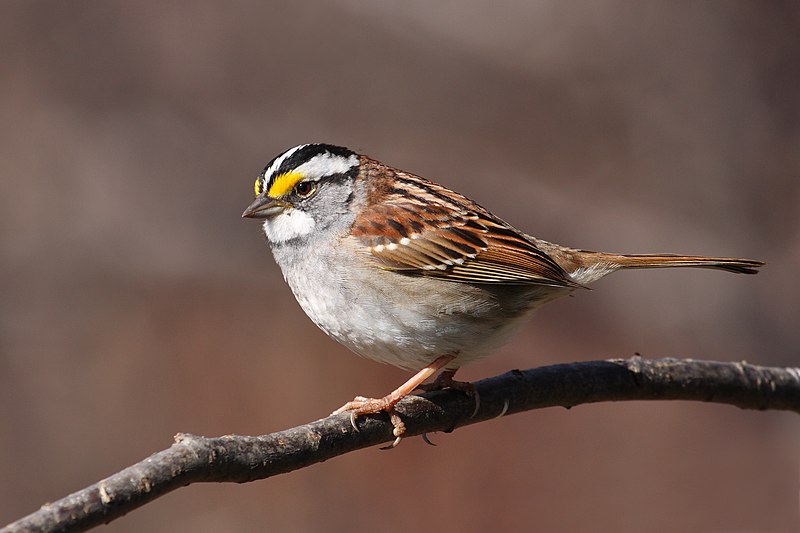
The White-throated Sparrow is a small passerine bird of the New World sparrow family Passerellidae.
It has distinctive yellow and black stripes on its head, white throat and chest with grey back and wings, along with light brown legs.
The scientific name “Zonotrichia albicollis” comes from Ancient Greek for ‘band’ (ζώνη) referring to its distinctive striped crown, and Latin for ‘white neck’ (albus collum).
These birds are usually found in wooded areas such as coniferous forests or deciduous habitats in North America where they feed mainly on insects during summer months; transitioning to seeds during winter.
They build their nests near ground level using grasses, twigs or moss lined with feathers.
White-throated Sparrows may be solitary but also form flocks when migrating southward each fall season which typically occurs over mid-late October through November depending on location within range.Scientific classification:
| Kingdom | Animalia |
| Phylum | Chordata |
| Class | Aves |
| Order | Passeriformes |
| Family | Passerellidae |
| Genus | Zonotrichia |
| Species | Z. albicollis |
7. Savannah Sparrow
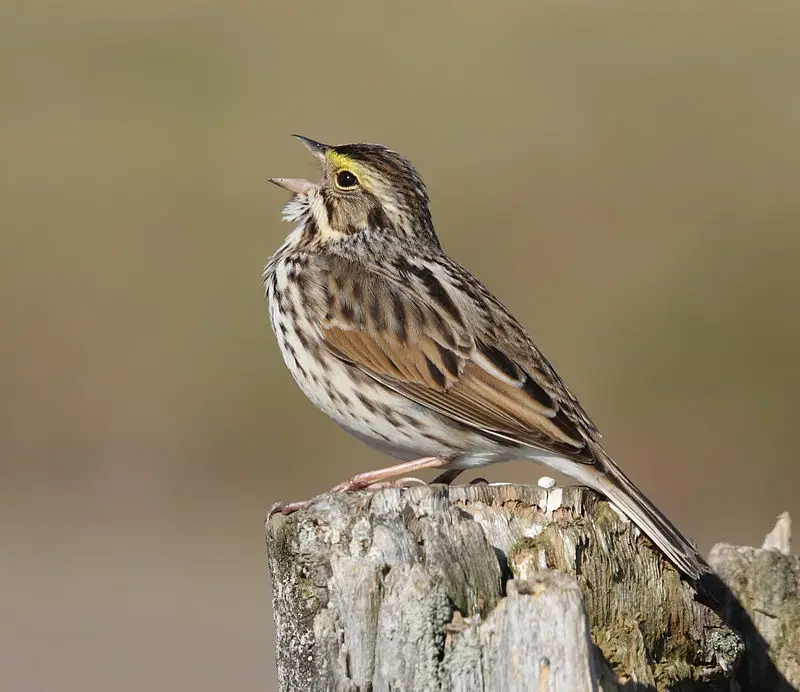
The Savannah Sparrow is a small, New World sparrow. It’s the only bird in its genus, Passerculus and can be distinguished from other similar species by comparing mtDNA NADH dehydrogenase subunit 2 and 3 sequences.
Its closest relative is the Ipswich sparrow which was once considered an independent species but now it’s seen as being part of the same family as this bird.
The male has yellowish-brown upper parts with darker streaks, white underparts with dark streaking on breast and flanks, orange wash to face sides plus two bold wingbars.
Females are slightly duller than males with less distinct markings on wings yet still showing some degree of variation between individuals across their range.Scientific classification:
| Kingdom | Animalia |
| Phylum | Chordata |
| Class | Aves |
| Order | Passeriformes |
| Family | Passerellidae |
| Genus | Passerculus |
| Species | P. sandwichensis |
Also Featured In: Savanna Birds You Need to See, Birds that Live in the Grasslands
8. Chipping Sparrow
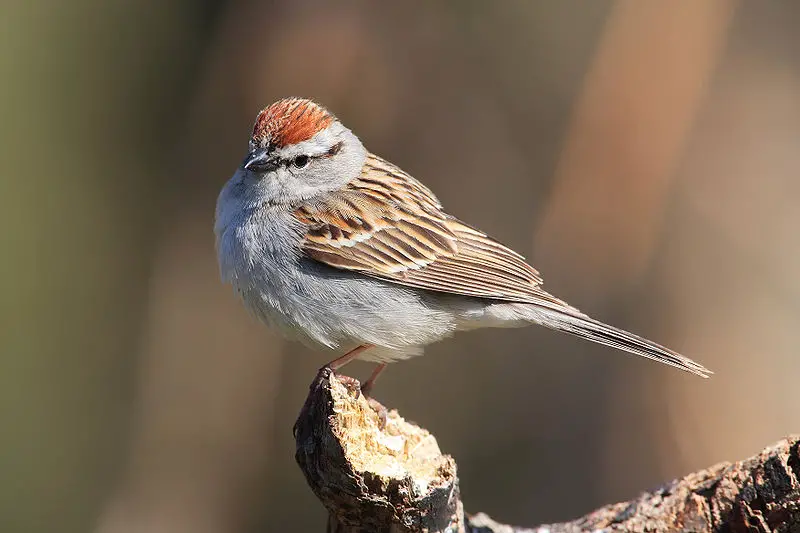
The Chipping Sparrow is a small passerine bird found across most of North America. It has two subspecies, the eastern and western chipping sparrows which migrate seasonally to overwinter in warmer climates.
The birds are grey above with white underparts, have a rufous cap with black stripes and large eyes surrounded by light brown feathers.
They feed mainly on seeds but can also be seen eating insects during breeding season when raising their young chicks.
These intrepid little birds live in open grasslands such as prairies or meadows where they build cup-shaped nests in trees or shrubs to raise their young family.
Their cheerful song often sounds like ‘chips’ hence its name; Chipping Sparrow.Scientific classification:
| Kingdom | Animalia |
| Phylum | Chordata |
| Class | Aves |
| Order | Passeriformes |
| Family | Passerellidae |
| Genus | Spizella |
| Species | S. passerina |
9. Lincoln’s Sparrow
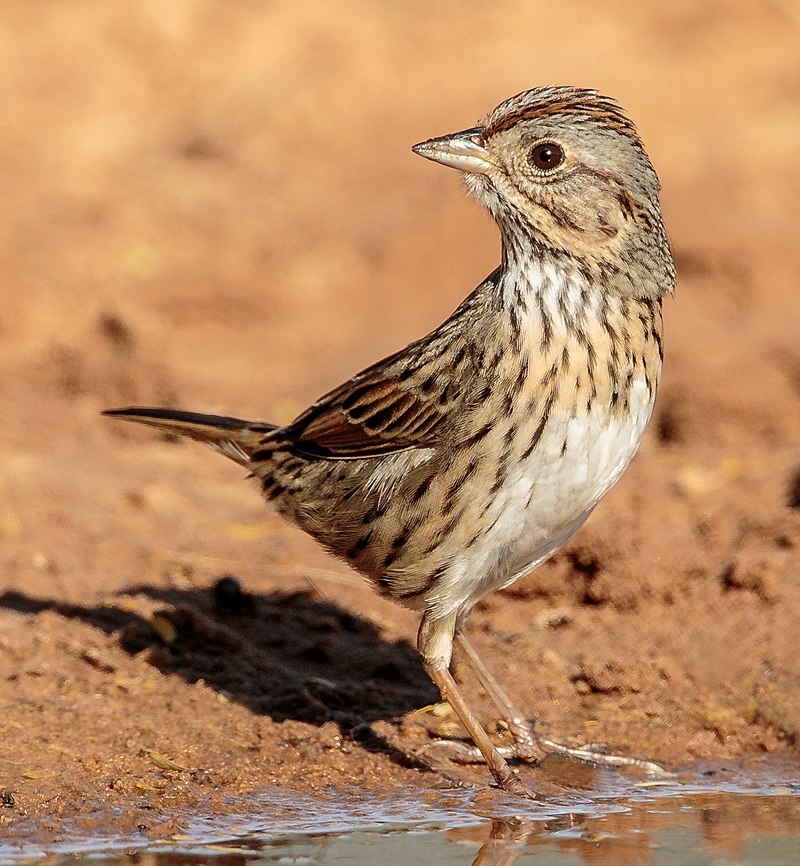
Lincoln’s sparrow is a small passerine bird native to North America. It has brown upperparts, white underparts and a distinctive light-gray eyebrow line above its eyes.
The species usually stays hidden in thick ground cover but can be identified by its sweet, wrenlike song.
Lincoln’s sparrow belongs to the genus Melospiza along with two other species: the Song Sparrow (M.melodia) and Swamp Sparrow (M. georgiana).
This elusive yet beautiful bird inhabits well-covered areas such as wetlands, grasslands, shrubland valleys, pastures and open woodlands across most of Canada and parts of northern USA throughout summer months before migrating south for winter season.Scientific classification:
| Kingdom | Animalia |
| Phylum | Chordata |
| Class | Aves |
| Order | Passeriformes |
| Family | Passerellidae |
| Genus | Melospiza |
| Species | M. lincolnii |
Also Featured In: Birds You’ll Find in South Texas , Birds in Pacific Northwest
10. Swamp Sparrow
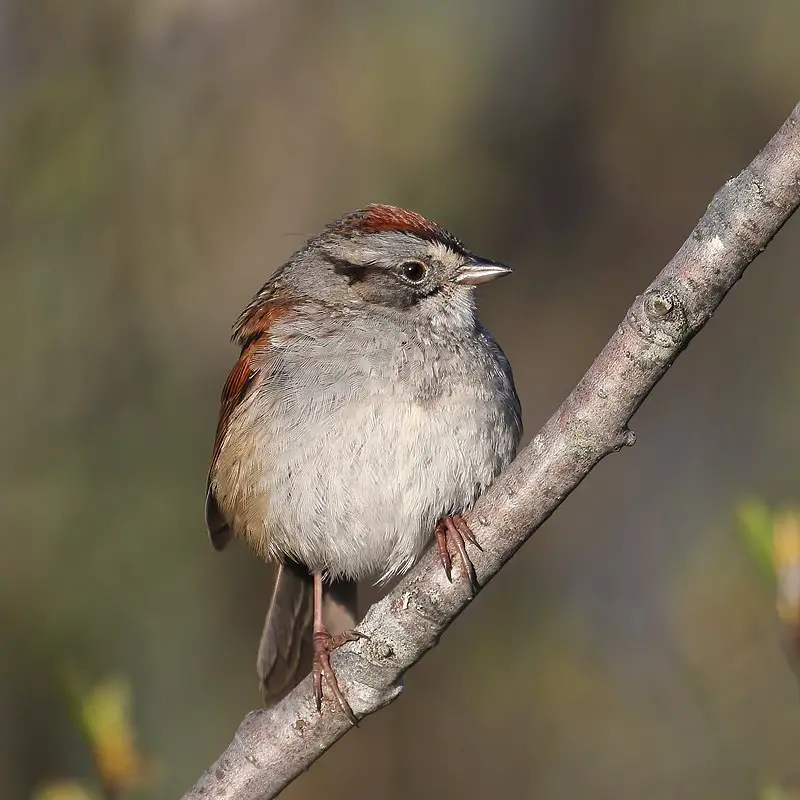
The Swamp Sparrow is a medium-sized bird found in the New World, closely related to the Song Sparrow.
It has rusty and buff streaked upperparts with an unstreaked gray breast, light belly, white throat and striking rusty wings.
The male’s head features a rust-coloured cap while both genders have grey faces with dark lines through their eyes.
Their bills are short and conical in shape which helps them feed on seeds as well as grains easily from ground or low vegetation.
They usually appear solitary but can also be seen foraging together near waterbodies such as swamps or marshes during migration season.Scientific classification:
| Kingdom | Animalia |
| Phylum | Chordata |
| Class | Aves |
| Order | Passeriformes |
| Family | Passerellidae |
| Genus | Melospiza |
| Species | M. georgiana |
Also Featured In: Swamps Birds You Should Know, Birds that can be Seen in October
11. Grasshopper Sparrow
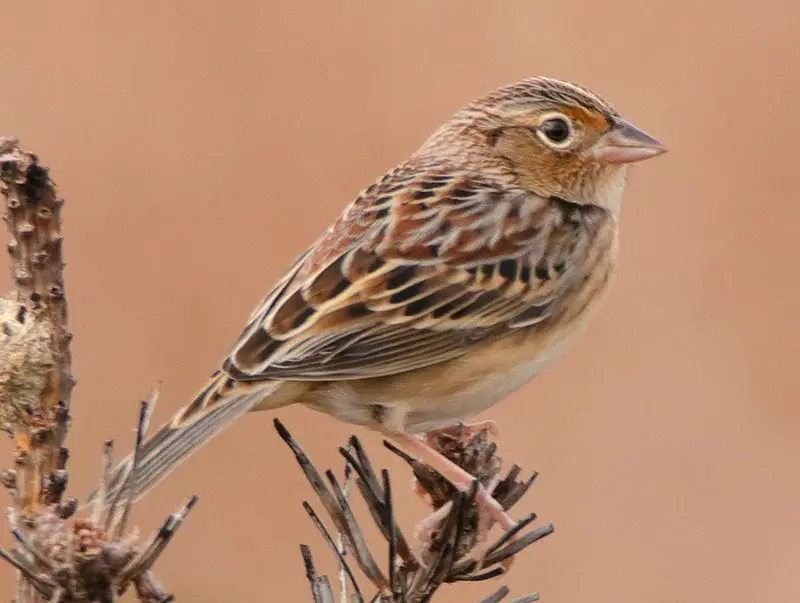
The Grasshopper Sparrow is a small sparrow from the New World. It inhabits grasslands and prairies, but will also colonize reclaimed grassland or crop fields.
This species prefers large areas of open grassland where it avoids trees and shrubs.
Its diet consists mainly of seeds, insects and spiders which it looks for on the ground while walking or running with occasional short flights to find food in tall vegetation.
The breeding season begins in late April when males sing their characteristic buzzy song to attract females; pairs build nests either low on the ground or aboveground among weeds and other cover plants.
These birds are key members of their native ecosystems as they control insect populations by feeding upon them as well as dispersing seed through consuming fruits.Scientific classification:
| Kingdom | Animalia |
| Phylum | Chordata |
| Class | Aves |
| Order | Passeriformes |
| Family | Passerellidae |
| Genus | Ammodramus |
| Species | A. savannarum |
Also Featured In: Birds that You’ll Find in Puerto Rico, Birds that Live in Manitoba
12. Fox Sparrow

The Fox Sparrow is a large New World sparrow and the only member of its genus Passerella. It has heavily spotted and streaked plumage that stands out from other species in the family.
The adults are larger than most other sparrows, with a distinctive central breast spot on their chest that adds to their unique look.
They mainly inhabit forest areas but can also be seen in open grasslands during migration season or when searching for food sources such as seeds and insects.
Their diet consists of various types of berries, fruits, grains, worms, snails and more depending on where they are located.
These birds have strong legs which allow them to dig into soil while looking for food making it easier to find what they need even under thick layers.Scientific classification:
| Kingdom | Animalia |
| Phylum | Chordata |
| Class | Aves |
| Order | Passeriformes |
| Family | Passerellidae |
| Genus | Passerella Swainson, 1837 |
| Species | P. iliaca |
13. Dark-Eyed Junco

The Dark-eyed Junco is a species of small, grayish sparrows that are found across much of temperate North America and in the Arctic during summer.
It was formally described by Carl Linnaeus in 1766, who named it after its distinctive dark eyes.
This bird has a very variable appearance due to the many different subspecies it contains, making its systematics difficult to unravel.
The plumage varies from white or light gray on their underparts with slate grey backs and wings; black heads with white outer tail feathers; brown head stripes; yellow bills; pink legs and feet; as well as various shades between all these colours.
They also have considerable sexual dimorphism where males tend to be more colourful than females but share similar characteristics such as short tails and rounded bodies – both sexes being around 16 cm long when fully grown.Scientific classification:
| Kingdom | Animalia |
| Phylum | Chordata |
| Class | Aves |
| Order | Passeriformes |
| Family | Passerellidae |
| Genus | Junco |
| Species | J. hyemalis |
14. Field Sparrow
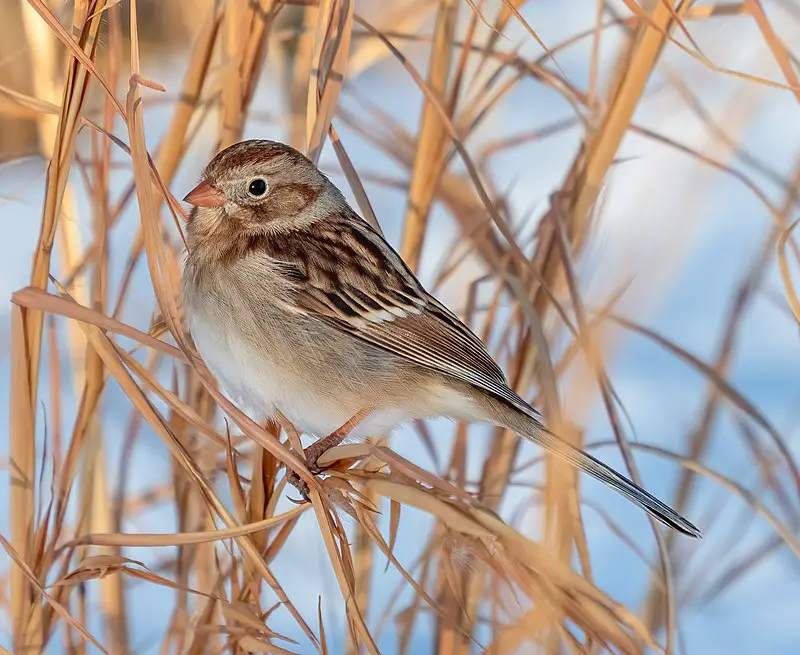
The Field Sparrow is a small bird that can be found across North America. It has a gray head with rust-colored crown and white eye-ring, while its upper parts are brown streaked with black and buff feathers.
Its breast is buff colored, belly white, and the tail forked. There are two color morphs of this species; one being darker in color than the other.
They measure about 140 mm long and weigh 12.5 grams on average; feeding primarily on seeds from grasses or weeds as well as insects during summer months.
The field sparrow’s song is often described as sweet whistles which it sings from an exposed perch like fence posts or trees tops.Scientific classification:
| Kingdom | Animalia |
| Phylum | Chordata |
| Class | Aves |
| Order | Passeriformes |
| Family | Passerellidae |
| Genus | Spizella |
| Species | S. pusilla |
Also Featured In: Autumn Birds You Should Know, Small Kentucky Birds
15. Harris’s Sparrow
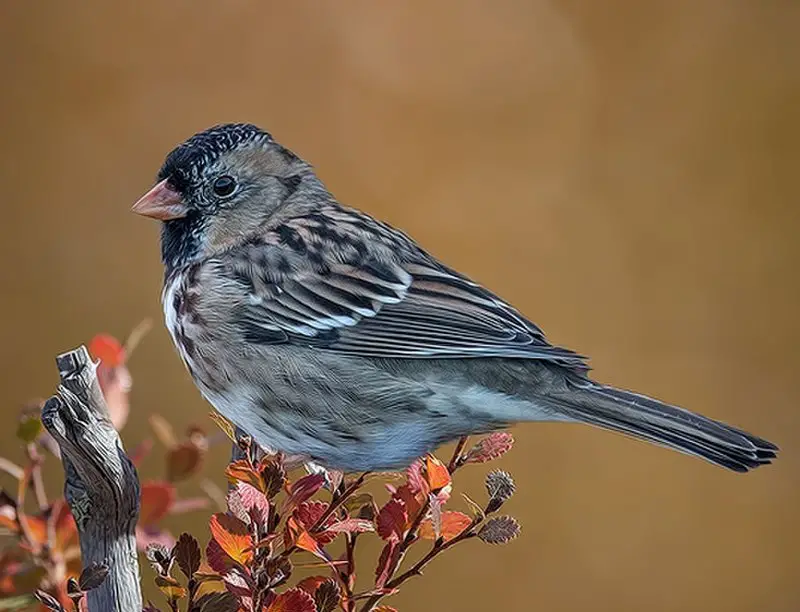
Harris’s sparrow is a large, distinctive bird that is endemic to Canada. It breeds in the north part of central Canada, mainly in Northwest Territories and Nunavut with its range extending into Manitoba and Saskatchewan.
During winter it migrates southward to states such as South Dakota, Texas or Nebraska where they can be found foraging on grasslands or prairies.
Its plumage includes white underparts with brown streaking on the sides accompanied by a grey-brown crown and black bill which makes it easy to identify.
Although not endangered yet due efforts should still be taken for conservation since their habitat loss has been affecting them adversely over time.Scientific classification:
| Kingdom | Animalia |
| Phylum | Chordata |
| Class | Aves |
| Order | Passeriformes |
| Family | Passerellidae |
| Genus | Zonotrichia |
| Species | Z. querula |
Also Featured In: Birds in Calgary You’ll Love to See, Common Northwest Territories Birds
16. Saltmarsh Sparrow
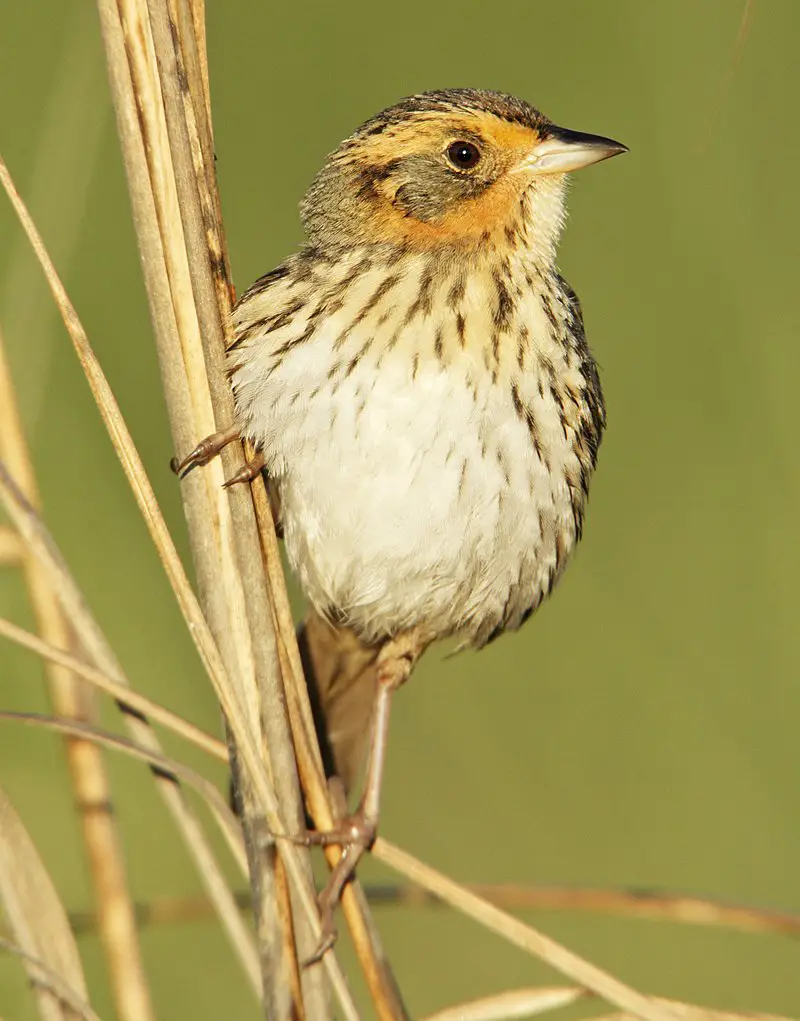
The Saltmarsh Sparrow is a small New World sparrow found in salt marshes along the Atlantic coast of the United States.
It was once thought to be part of the Sharp-tailed Sparrow species, but now it has been classified as its own species.
This bird is becoming increasingly endangered due to habitat loss caused by climate change and urbanization which destroys their natural habitats.
To help protect this beautiful bird, conservation efforts are being made such as creating wildlife refuges or restoring wetlands that provide essential food sources for them.
As long as we can take action on preserving these birds’ habitats, they may have a future chance at survival in our rapidly changing world.Scientific classification:
| Kingdom | Animalia |
| Phylum | Chordata |
| Class | Aves |
| Order | Passeriformes |
| Family | Passerellidae |
| Genus | Ammospiza |
| Species | A. caudacuta |
Also Featured In: Pine Island Birds You Should Know,
17. Eastern Towhee

The Eastern Towhee is a large New World sparrow, native to brushy areas of eastern North America. These birds have distinct black and white markings, with chestnut brown underparts.
They nest either low in bushes or on the ground beneath shrubs. Northern towhees are known for migrating south during the winter months.
In recent decades, taxonomy debates have left some questioning whether this bird should remain its own species or be grouped together with the Spotted Towhee as one species — Rufous-sided Towhee.
This lively songbird has a bubbly personality and can often be seen hopping around on branches looking for food such as insects, fruits and seeds.Scientific classification:
| Kingdom | Animalia |
| Phylum | Chordata |
| Class | Aves |
| Order | Passeriformes |
| Family | Passerellidae |
| Genus | Pipilo |
| Species | P. erythrophthalmus |
18. Vesper Sparrow
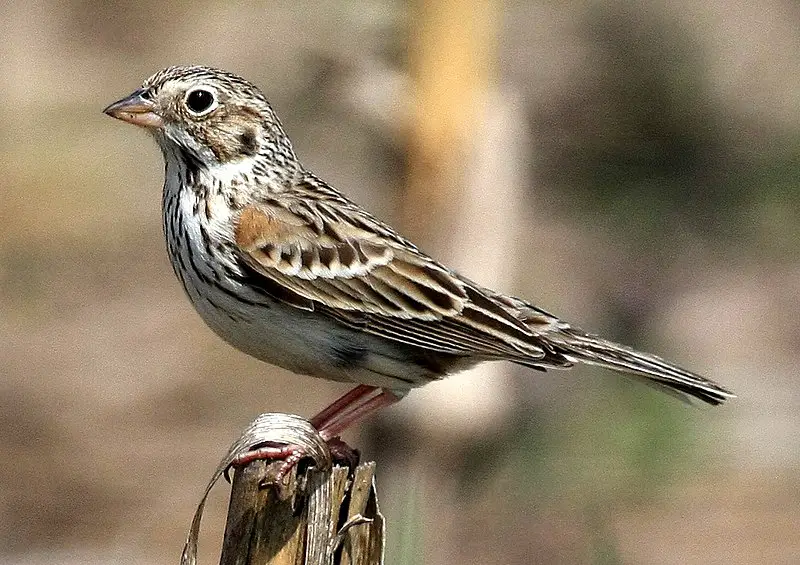
The Vesper Sparrow is a medium-sized New World sparrow that inhabits grassy fields and open woodlands. It’s the only species in its genus, Pooecetes, which translates to ‘grass dweller’.
Adults have light brown upperparts with darker streaking, as well as lighter underparts also with dark streaks. They are believed to be most closely related to Lark Sparrows.
Three features make them unique; they lack eye stripes or wing bars and have white outer tail feathers when seen from below during flight.
Their song is quite variable but often includes two distinct notes followed by a trill of higher pitched notes at the end – all together creating an ‘oh sweet Canada’ sound.Scientific classification:
| Kingdom | Animalia |
| Phylum | Chordata |
| Class | Aves |
| Order | Passeriformes |
| Family | Passerellidae |
| Genus | Pooecetes Baird, 1858 |
| Species | P. gramineus |
19. Black-Throated Sparrow
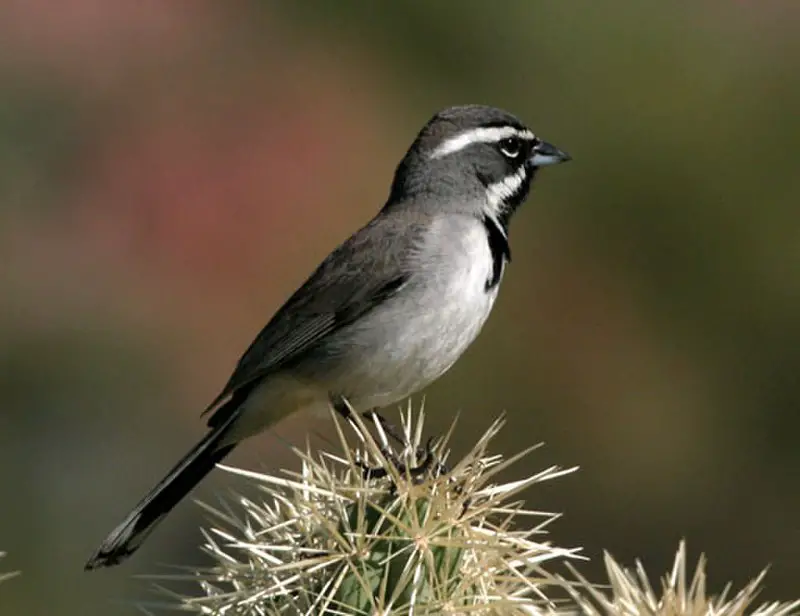
The black-throated sparrow is a small bird native to the southwestern United States and Mexico.
It is known for its striking features, including black throats with white stripes on either side as well as buffy, white underparts.
They are also recognized by their long tails and dark upper parts, which often have yellowish or rusty markings near the wings.
The birds prefer arid habitats such as deserts and scrublands; however they can be found in other areas too during migration periods.
These adaptable creatures feed on insects, seeds and grains from plants like grasses or cacti – making them an important species when it comes to sustaining healthy ecosystems.Scientific classification:
| Kingdom | Animalia |
| Phylum | Chordata |
| Class | Aves |
| Order | Passeriformes |
| Family | Passerellidae |
| Genus | Amphispiza Coues, 1874 |
| Species | A. bilineata |
Also Featured In: Phoenix Birds You Should Know, Birds that Live in the Deserts
20. Lark Sparrow
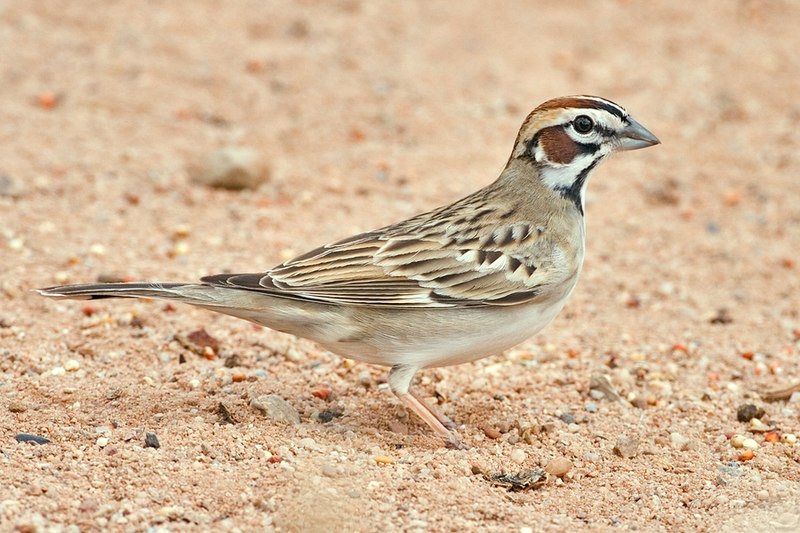
The Lark sparrow is a large New World Sparrow and the only member of its genus Chondestes. It has an extensive range, breeding throughout southern Canada, much of the United States and northern Mexico.
While it is not as common in eastern parts of its range, with populations decreasing over time.
Resident birds can be found in Mexico and adjacent states but other birds migrate south for wintering grounds further away from their nesting sites.
The lark sparrow sports a distinctive black streak on either side of its white throat area which helps to identify them amongst similar looking species such as the clay-colored or Vesper Sparrows that share some overlapping habitat ranges across North America.Scientific classification:
| Kingdom | Animalia |
| Phylum | Chordata |
| Class | Aves |
| Order | Passeriformes |
| Family | Passerellidae |
| Genus | Chondestes Swainson, 1827 |
| Species | C. grammacus |
21. LeConte’s Sparrow
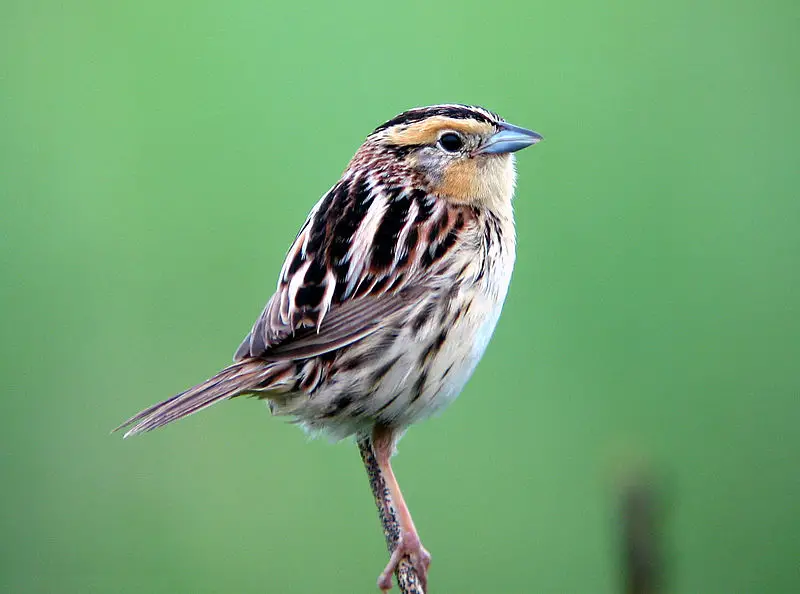
LeConte’s sparrow is a small, secretive bird found in North America. It prefers to stay on the ground and can often be seen scurrying through tall grasses when disturbed.
These birds are notoriously difficult to spot and usually only flush at close distances of 1-3m.
They rarely take flight and instead opt for running away or hiding within vegetation if encountered by predators or humans alike.
Their diet consists mainly of seeds, fruits, insects and other invertebrates which they search for on the ground with their long bills adapted especially suited for this purpose.Scientific classification:
| Kingdom | Animalia |
| Phylum | Chordata |
| Class | Aves |
| Order | Passeriformes |
| Family | Passerellidae |
| Genus | Ammospiza |
| Species | A. leconteii |
22. Snow Bunting
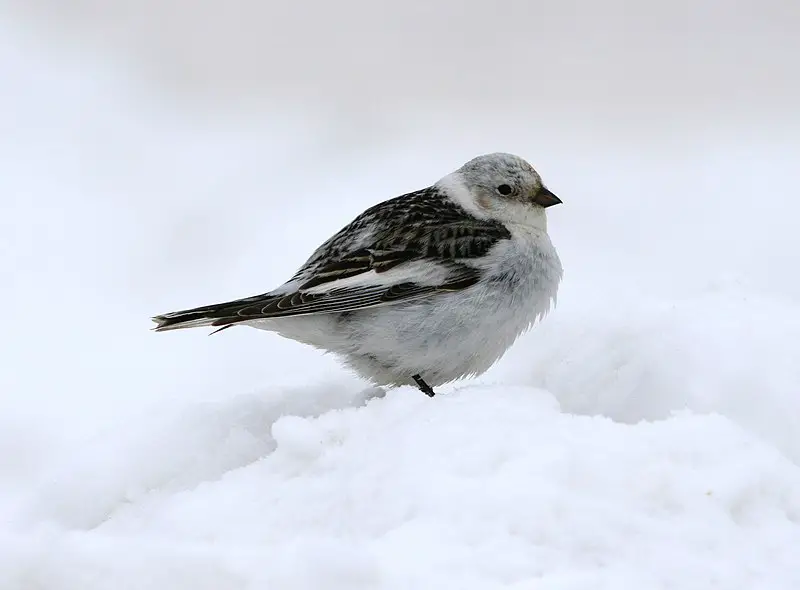
The snow bunting is a small and colourful passerine bird found in the Arctic regions of the northern hemisphere.
With its bright white feathers, black markings on its wings and tail, it stands out amongst other birds that inhabit these cold climates.
This species has adapted well to surviving in this harsh environment; they nest under boulders or rocks so their eggs are shielded from predators and blizzards alike.
They feed mainly on insects during summer months but switch to seeds when winter arrives as they seek food sources which will not freeze over with ice.
The snow bunting is an important part of the local ecosystem due to providing sustenance for larger animals such as foxes and owls who rely upon them for survival throughout wintertime.Scientific classification:
| Kingdom | Animalia |
| Phylum | Chordata |
| Class | Aves |
| Order | Passeriformes |
| Family | Calcariidae |
| Genus | Plectrophenax |
| Species | P. nivalis |
23. Clay-Colored Sparrow
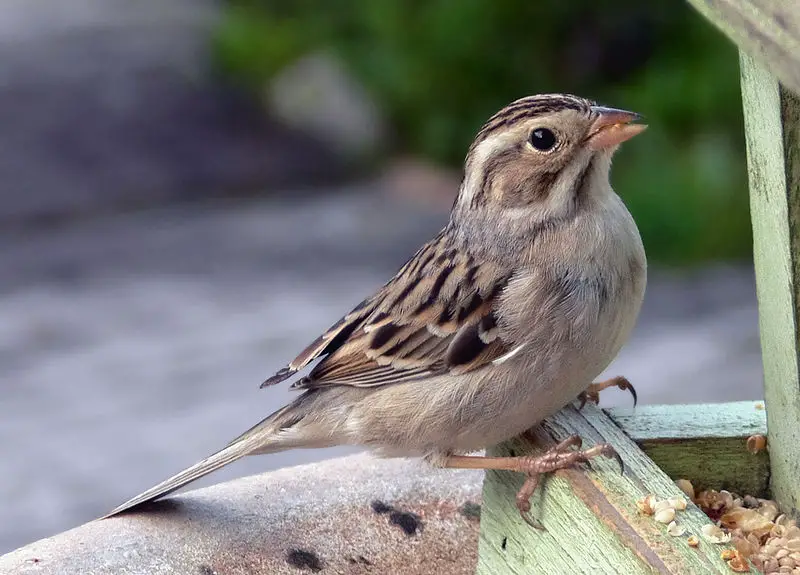
The Clay-colored sparrow is a small, light brown bird found in North America. It has pale underparts with darker streaks on its back and a white line above the eyes that contrasts against its dark crown.
Its wings have wing bars and it also has a distinctive light brown cheek patch. Its short bill is typically pale in colour which adds to its unique appearance.
This friendly little bird often feeds near houses or gardens where they can easily find food sources such as seeds and insects while making cheerful chirps during their search for sustenance.
They are an important part of the local ecosystem since they help keep insect numbers down, allowing farmers to have better harvests without needing pesticides.Scientific classification:
| Kingdom | Animalia |
| Phylum | Chordata |
| Class | Aves |
| Order | Passeriformes |
| Family | Passerellidae |
| Genus | Spizella |
| Species | S. pallida |
Also Featured In: Summer Birds that Live around Us, Common Birds in Saskatchewan
24. Nelson’s Sparrow

Nelson’s sparrow is a small New World sparrow named after the American naturalist, Edward William Nelson. It was once considered to be part of a single species known as the sharp-tailed sparrow.
These birds have brownish upperparts with gray on their crowns and wings that are edged in white.
They have buffy underparts which become paler towards their bellies and they feature two prominent stripes along either side of their throats.
Males tend to be darker than females, particularly during breeding season when they can show chestnut patches on their heads and necks as well as black streaks down its flanks.
This bird prefers wet areas for nesting such as marshes, swamps or grasslands near water where it feeds mainly on insects but also consumes seeds from various plants including wild rice grains found in shallow waters nearby its habitats.Scientific classification:
| Kingdom | Animalia |
| Phylum | Chordata |
| Class | Aves |
| Order | Passeriformes |
| Family | Passerellidae |
| Genus | Ammospiza |
| Species | A. nelsoni |
25. Brewer’s Sparrow
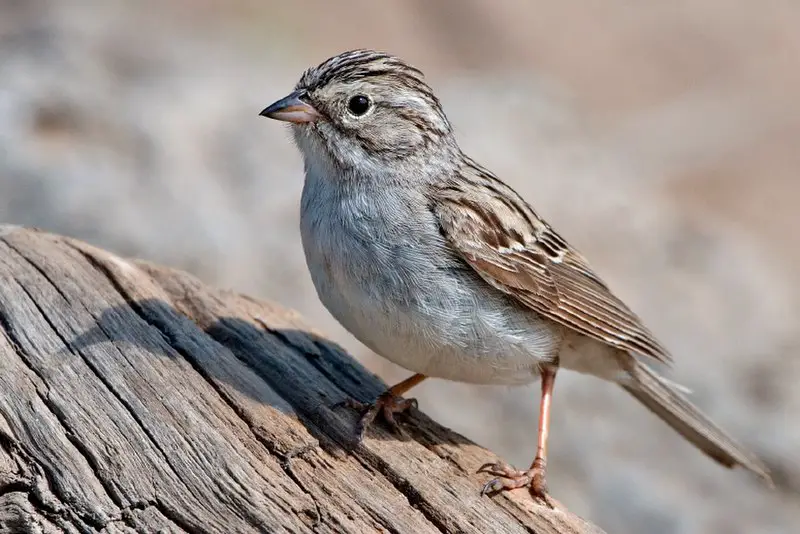
The Brewer’s Sparrow is a small, slim sparrow native to North America. It has grey-brown upperparts with dark streaks on its crown and pale eye-rings.
Its wings are brown with light bars, while the underparts are pale grey in color.
The bill is mostly pale but tipped in dark colors and it has long tail feathers which help it maneuver through dense vegetation easily.
This bird was named after ornithologist Thomas Mayo Brewer for his contributions to bird study during the 19th century.
During winters they gather together in large flocks often seen perched atop tall shrubs or trees singing their distinct songs of “seet seet” or “tisi tsi” throughout the day as they search for food amongst thickets of grasses and other vegetation coverings near wetlands that provide necessary sustenance over winter months when insect populations diminish significantly due to cold temperatures prevailing outside at night time hours.Scientific classification:
| Kingdom | Animalia |
| Phylum | Chordata |
| Class | Aves |
| Order | Passeriformes |
| Family | Passerellidae |
| Genus | Spizella |
| Species | S. breweri |
Also Featured In: Birds that Live in Arizona Desert,
26. Dickcissel
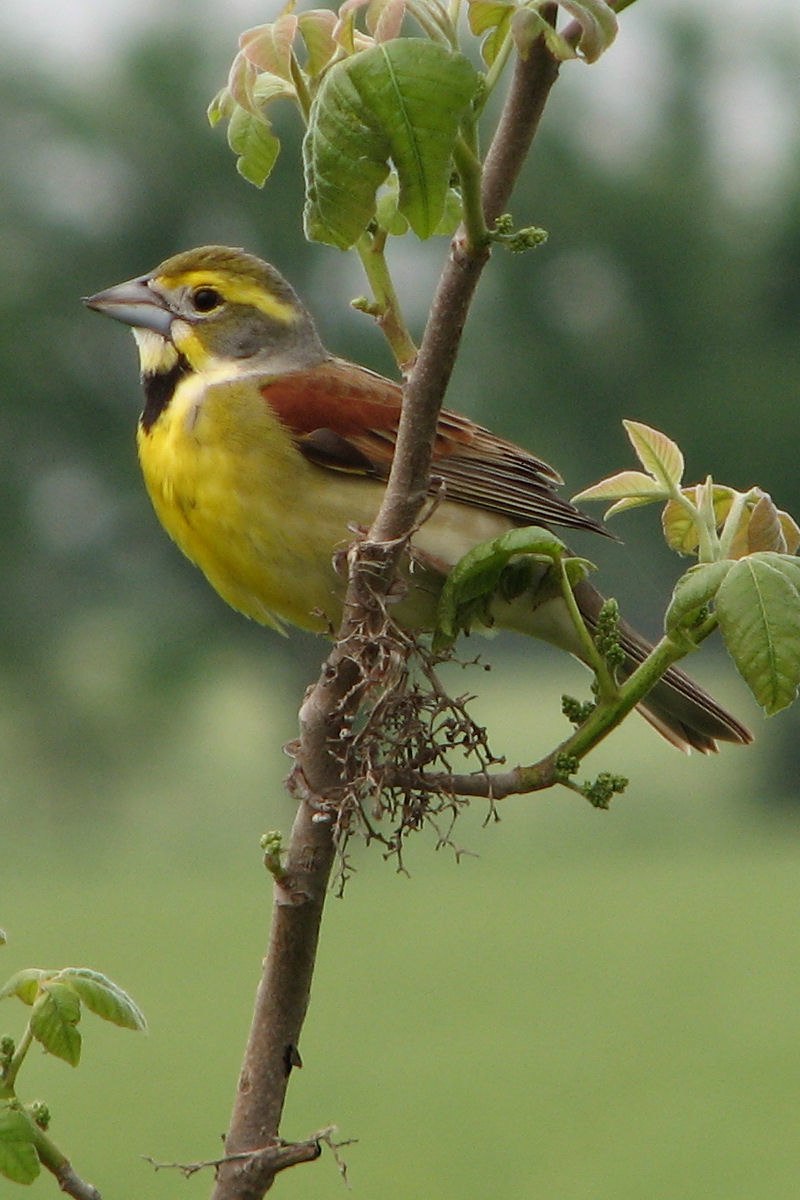
The Dickcissel is a small migratory bird belonging to the Cardinalidae family. It breeds in grasslands of the Midwestern US, and winters in Central America, northern Colombia and Venezuela.
Being the only member of its genus Spiza, it stands out from other birds with its distinctive song that sounds like “dick-sis-sel”.
With a light brown body and black streaks on its wings as well as chestnut colored shoulders and crowns, these birds are quite attractive to watch.
They also have short bills which they use while foraging through tall prairie vegetation or searching around fence posts for insects.
Although not endangered yet, their population has declined due to loss of habitat caused by human development so conservation efforts should be taken up soon.Scientific classification:
| Kingdom | Animalia |
| Phylum | Chordata |
| Class | Aves |
| Order | Passeriformes |
| Family | Cardinalidae |
| Genus | Spiza Bonaparte, 1824 |
| Species | S. americana |
Also Featured In: Common Birds of Prairie, Red Birds You’ll See in Oklahoma
27. Bachman’s Sparrow
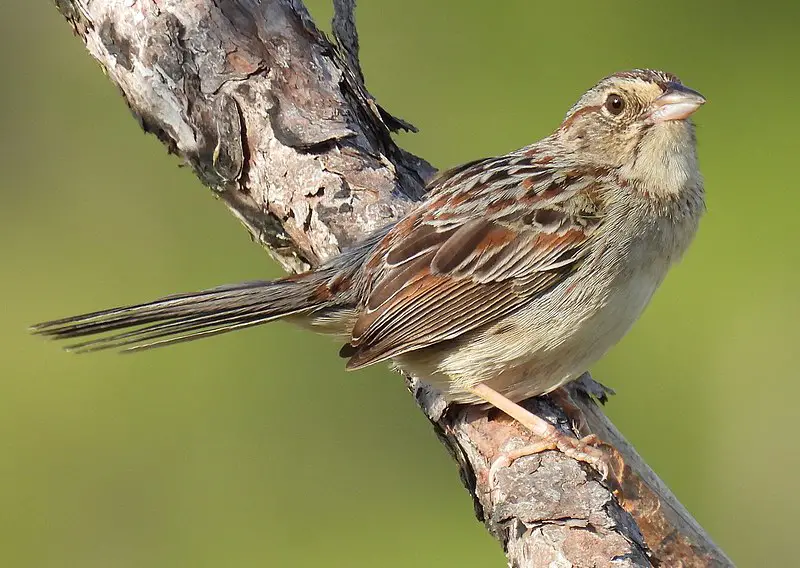
Bachman’s sparrow is a small American bird native to the southeastern United States. It was named in honor of Reverend John Bachman and has rufous brown upperparts, gray face with a rufous eyestripe, white throat and underparts with black streaks on breast, sides and flanks.
Its wings are grayish-brown while its tail is rusty-brown with white tips. This species mainly feeds on seeds, insects and arthropods but occasionally also eats fruits such as berries or figs.
They prefer open pine savannahs for breeding where they build their nests among tangled shrubs at ground level near clearings or roadsides.
The female usually lays four eggs which hatch after about two weeks incubation period by both parents taking turns tending the nestlings until fledging occurs 12–14 days later.Scientific classification:
| Kingdom | Animalia |
| Phylum | Chordata |
| Class | Aves |
| Order | Passeriformes |
| Family | Passerellidae |
| Genus | Peucaea |
| Species | P. aestivalis |
Also Featured In: Brown Birds that Live in Michigan,
28. Golden-Crowned Sparrow
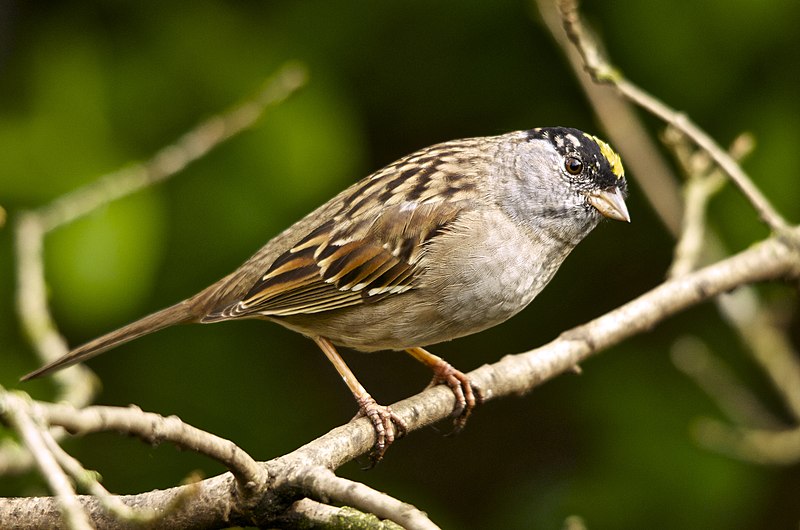
The golden-crowned sparrow is a large New World bird found in the western part of North America. It belongs to the genus Zonotrichia, made up of five species and has no subspecies.
This bird is closely related to the white-crowned sparrow as studies show their mitochondrial DNA evolves at a similar rate.
The most recognizable feature on this beautiful creature are its distinctive yellow stripes near its forehead that appear almost like an orange crown when seen from afar.
Its plumage can range from grey browns in winter months, to dull yellows and oranges during breeding season which typically occurs between April and July.
These birds are often seen foraging through leaf litter or along grassy fields looking for seeds, insects and berries to eat while they sing sweet melodies throughout their habitat.Scientific classification:
| Kingdom | Animalia |
| Phylum | Chordata |
| Class | Aves |
| Order | Passeriformes |
| Family | Passerellidae |
| Genus | Zonotrichia |
| Species | Z. atricapilla |
Also Featured In: Birds That Live around Seattle, Birds that Live in San Francisco Bay Area
29. Henslow’s Sparrow
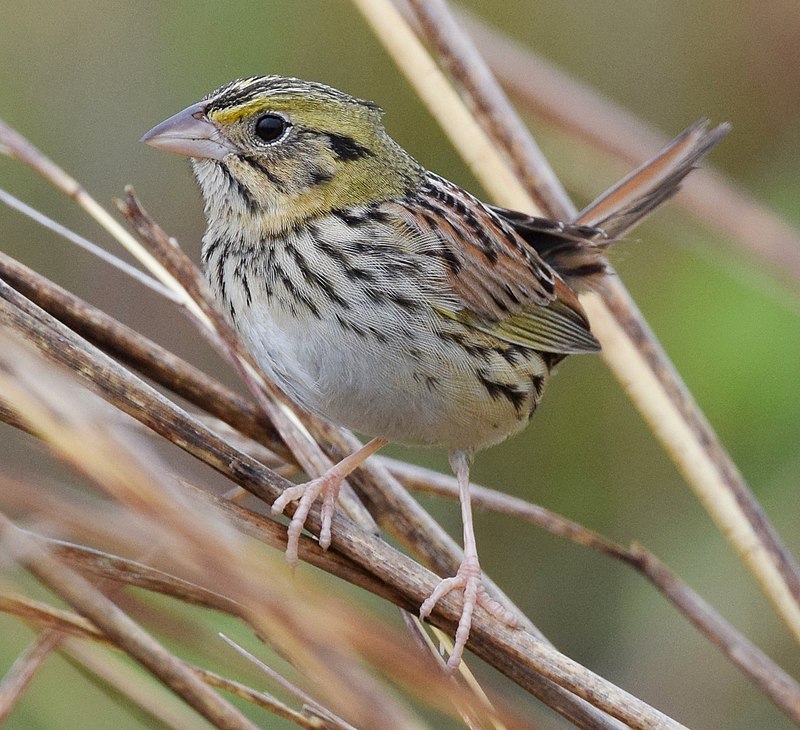
Henslow’s sparrow is a small passerine bird in the family Passerellidae named after John Stevens Henslow.
It has streaked brown upperparts, light brown breast with streaks, white belly and throat, and a pale stripe on its crown.
It also has yellowish-brown wings with black tips, long tail feathers that have central stripes of grey or rufous coloration edged by white lines.
Male birds are slightly larger than females and may sport brighter plumage during mating season when they sing to attract mates from nearby shrubbery or grassland habitats where they usually reside in pairs or groups of up to four individuals.
Despite their shyness around humans these birds provide important environmental services as part of food webs across North America due to their insectivorous diet which helps control pest populations near farms and gardens.Scientific classification:
| Kingdom | Animalia |
| Phylum | Chordata |
| Class | Aves |
| Order | Passeriformes |
| Family | Passerellidae |
| Genus | Centronyx |
| Species | C. henslowii |
30. Lapland Longspur
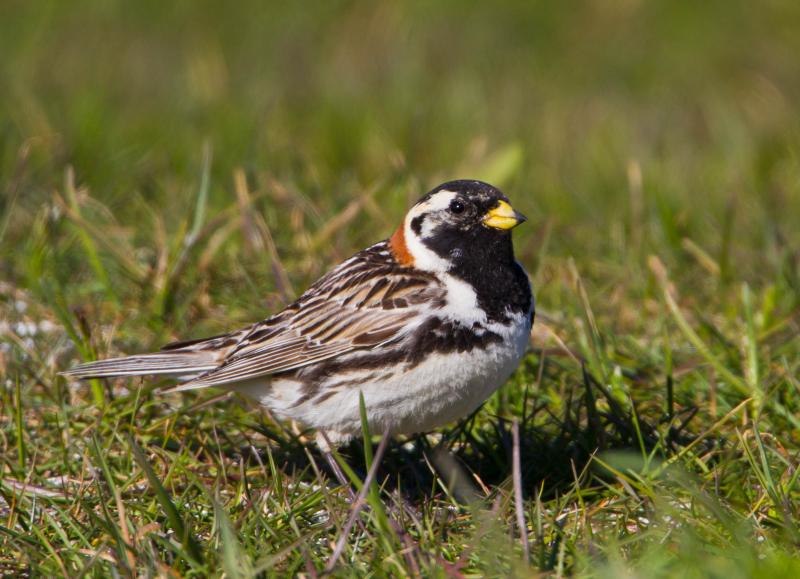
The Lapland longspur is a passerine bird of the Calcariidae family, which has been differentiated from Old World finches.
It gets its name from its hindfoot claws that are considerably longer than usual for most birds.
The genus Calcarius in Latin translates to “spurs”, while lapponicus refers to Lapland where it can be commonly found.
This small sparrow-like bird with black and brown plumage measures around 15 cm in length and weighs just 20 gm on an average.
They feed mainly on seeds and insects during summer months but consume mostly leftover grain by humans when cold winter sets in.
These nomadic species migrate southwards every year before temperatures start dropping too low, making them truly fascinating creatures.Scientific classification:
| Kingdom | Animalia |
| Phylum | Chordata |
| Class | Aves |
| Order | Passeriformes |
| Family | Calcariidae |
| Genus | Calcarius |
| Species | C. lapponicus |
Also Featured In: Birds that Live in Greenland, Tundra Birds
31. Buff-Bellied Pipit
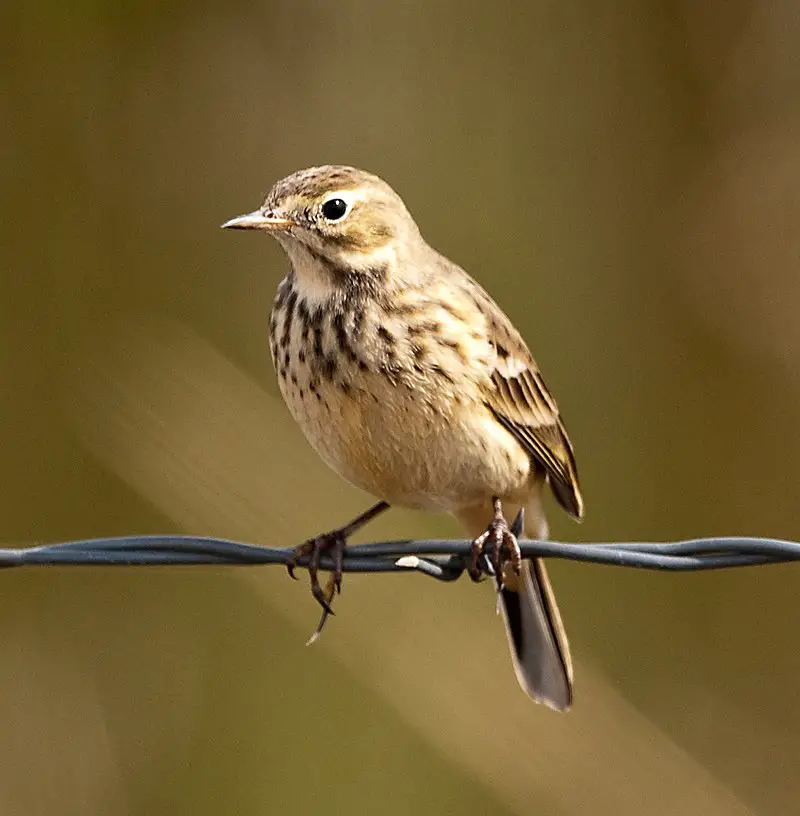
The Buff-bellied Pipit is a small songbird found across the northern Pacific, first described by Marmaduke Tunstall in his 1771 Ornithologia Britannica.
Formerly classified as a form of the Water pipit, it’s known as “American pipit” in North America and “buff-bellied pipit” in Eurasia.
This bird has brown upperparts and buff underparts with streaks on its breast.
Its tail feathers have white edges while its wings are blackish with pale fringes to each feather.
In flight this species displays a rapid twisting action which helps identify them from other similar birds flying nearby.
They feed mainly on insects but also eat seeds during winter months when there aren’t many insects around for them to catch and feast upon.Scientific classification:
| Kingdom | Animalia |
| Phylum | Chordata |
| Class | Aves |
| Order | Passeriformes |
| Family | Motacillidae |
| Genus | Anthus |
| Species | A. rubescens |
32. Sagebrush Sparrow
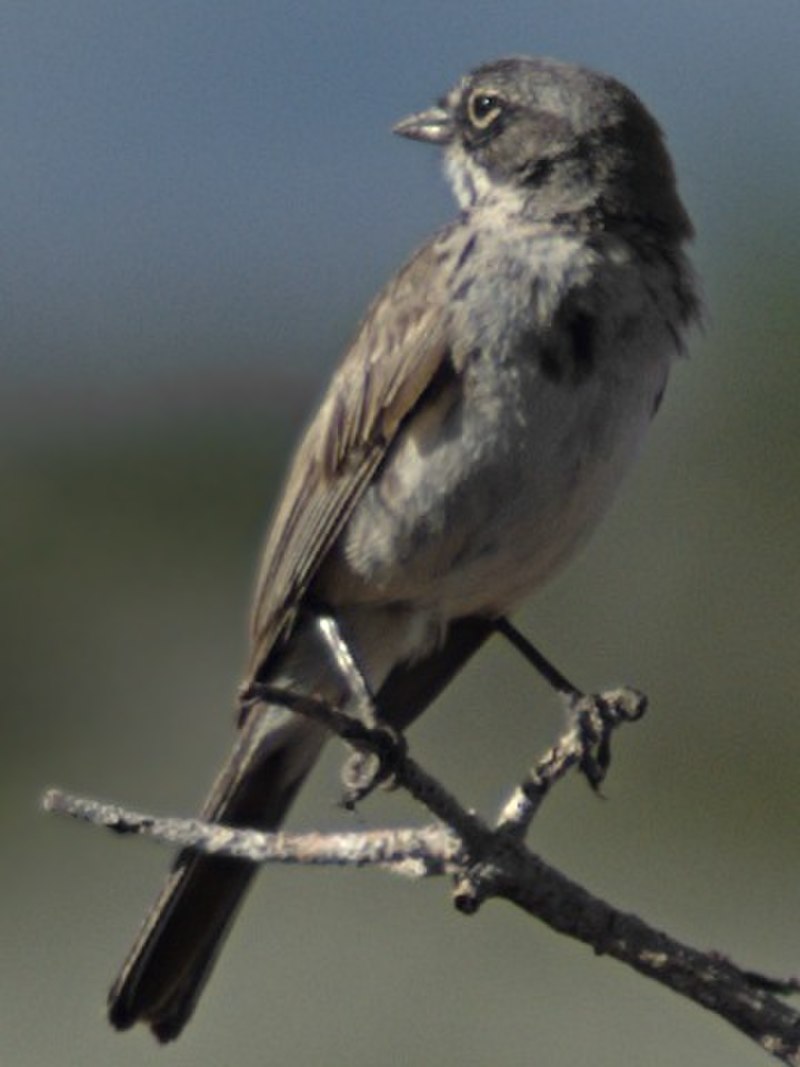
The Sagebrush Sparrow is a medium-sized sparrow found in the western United States and northwestern Mexico.
It was recently moved to its own genus, Artemisiospiza nevadensis, after evidence suggested it differed from other species of Amphispiza.
The bird typically inhabits sagebrush habitats but can also be spotted amongst brushy stands of saltbush and chamise.
They have grayish brown crowns with white supercilium stripes that continue from their eyes down onto their neck’s nape area.
Their underparts are pale buff colored with dark streaks on breast sides and flanks as well as gray tails having few narrow white edges along outer rectrices feathers.
This species prefers open shrublands for nesting while they feed mainly on insects during summer months when available, including seeds throughout winter season too.Scientific classification:
| Kingdom | Animalia |
| Phylum | Chordata |
| Class | Aves |
| Order | Passeriformes |
| Family | Passerellidae |
| Genus | Artemisiospiza |
| Species | A. nevadensis |
33. Lark Bunting
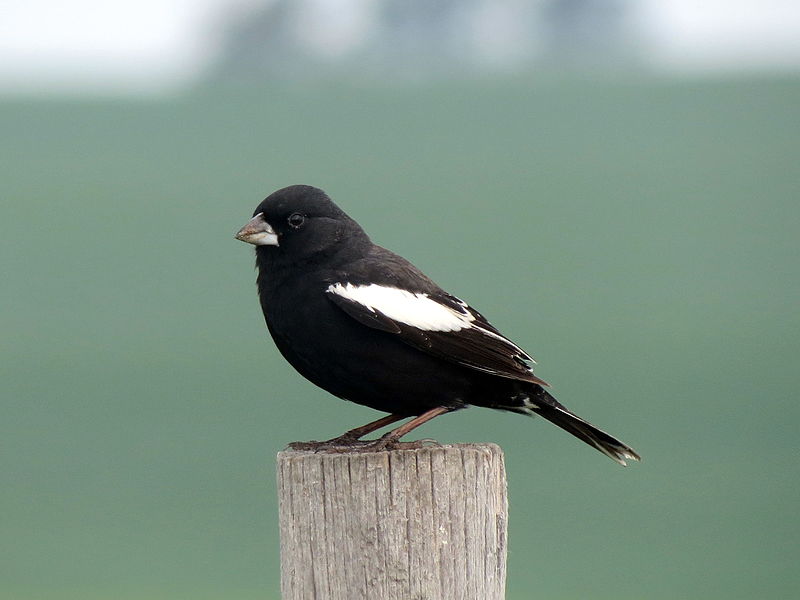
The Lark Bunting is a medium-sized sparrow native to central and western North America. It was designated the state bird of Colorado in 1931, making it an important part of local culture.
The species is monotypic; meaning it’s not related to any other genera out there.
J.K Townsend first described this fascinating bird back in 1837 after finding a specimen during his travels with Major Stephen H Long on their expedition up the Platte River valley through Nebraska and Wyoming into South Dakota.
This friendly little creature has black feathers at its crown, grey wings and tail, white breast streaked with black patches – all contributing together to create one colorful picture.
Its habitat ranges from grasslands across prairies as well as cultivated farms where they usually nest low down on ground level or within shrubs for safety purposes.
With such beautiful features along with its cheerful chirps that can be heard throughout springtime mornings, no wonder why this majestic avian holds so many admirers amongst nature lovers everywhere.Scientific classification:
| Kingdom | Animalia |
| Phylum | Chordata |
| Class | Aves |
| Order | Passeriformes |
| Family | Passerellidae |
| Genus | Calamospiza Bonaparte, 1838 |
| Species | C. melanocorys |
Also Featured In: Birds That Live in Colorado, Black And White Birds You Don’t Know About
34. Spotted Towhee
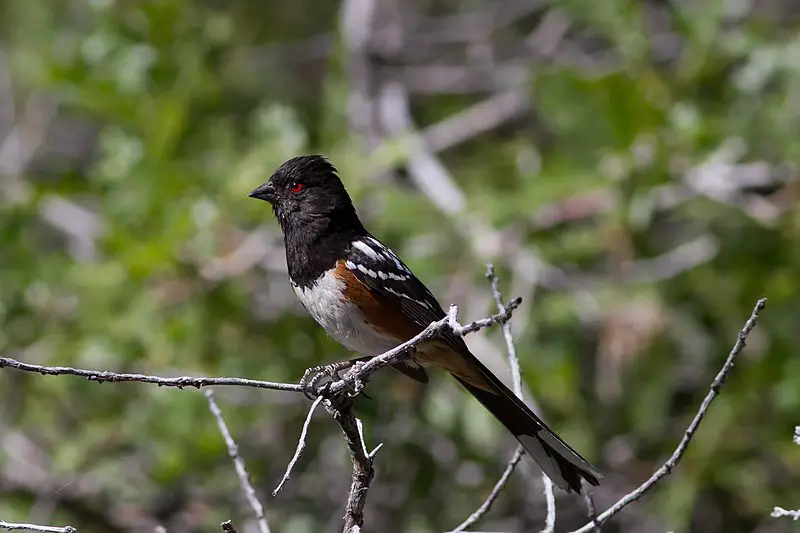
The spotted towhee is a large New World sparrow, easily recognizable by its distinctive black and white feathers. It’s native range stretches from the Pacific Northwest to parts of Mexico and Central America.
Its call can be harsher than the eastern towhee, with a more varied repertoire including whistles, trills, chirps and rattles.
This bird was once considered to be part of one species known as rufous-sided towhees until 1995 when it was formally classified into two separate species – the spotted towhee (Pipilo maculatus) & eastern towee (Pipilio erythrophthalmus).
They prefer habitats such as dense shrubbery or thickets near open areas like meadows or fields making them hard to spot in their natural environment but they are quite common across much of North America.Scientific classification:
| Kingdom | Animalia |
| Phylum | Chordata |
| Class | Aves |
| Order | Passeriformes |
| Family | Passerellidae |
| Genus | Pipilo |
| Species | P. maculatus |
35. Seaside Sparrow
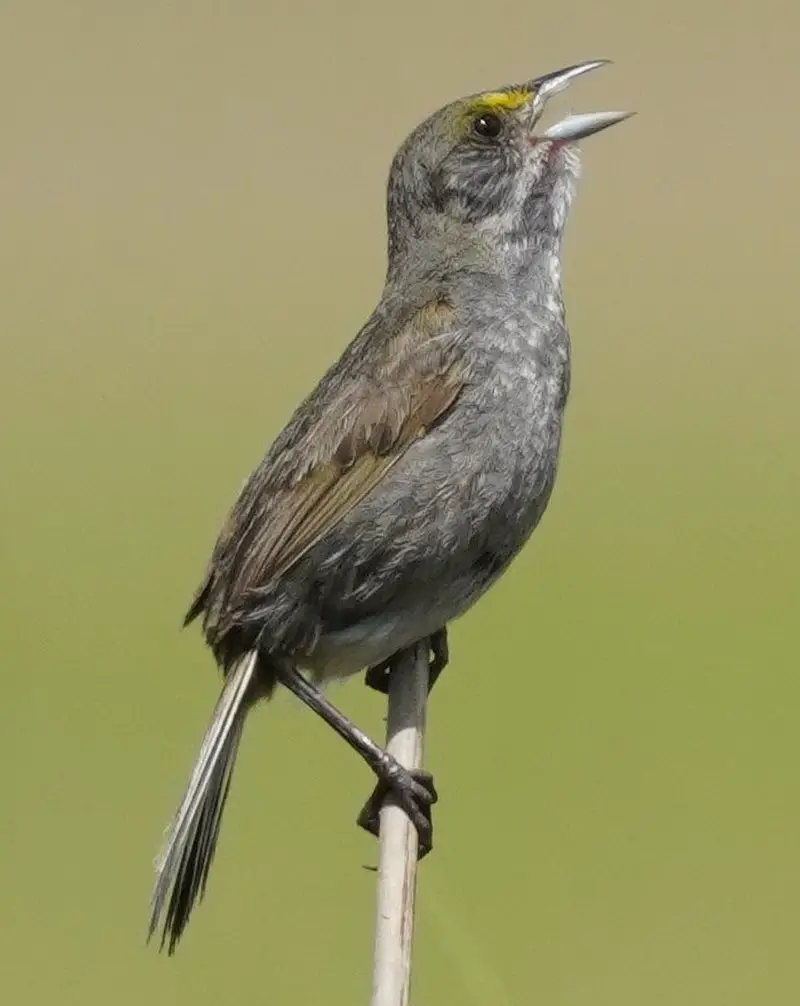
The Seaside sparrow is an American bird native to the coastal regions of North America. Its upperparts are a brownish color with gray on its crown and nape, while its breast has a gray-buff hue featuring dark streaks.
There’s also a white throat and short, pointed tail which features a small yellow streak above the eye. The typical lifespan for these birds is 8 to 9 years maximum.
They prefer moist habitats such as marshes, mangroves and saltwater estuaries where they feed mostly on seeds and insects found in shallow waters or vegetation near shorelines.
During breeding season you can identify them by their singing males who sing from hidden perches during dawn or dusk hours.Scientific classification:
| Kingdom | Animalia |
| Phylum | Chordata |
| Class | Aves |
| Order | Passeriformes |
| Family | Passerellidae |
| Genus | Ammospiza |
| Species | A. maritima |
Also Featured In: Everglades Birds,
36. Spanish Sparrow
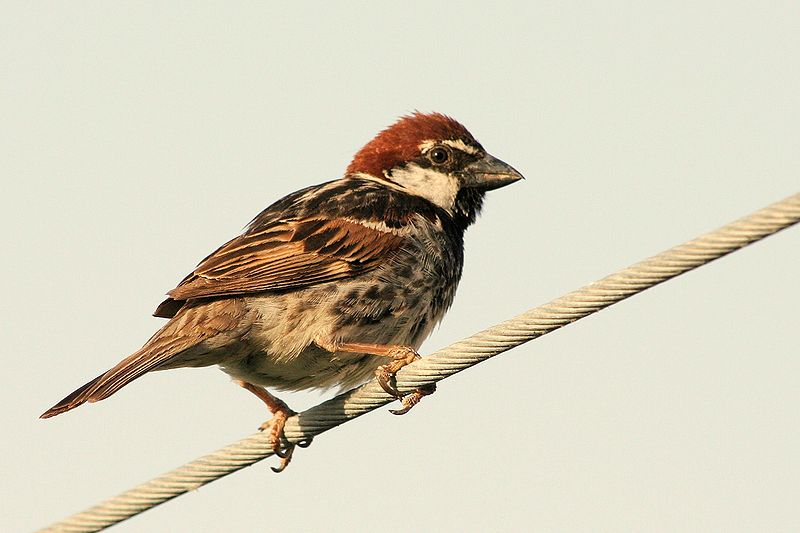
The Spanish sparrow or willow sparrow (Passer hispaniolensis) is a beautiful member of the passerine bird family Passeridae, found mainly in the Mediterranean region and south-west and central Asia.
With its striking colouration – having chestnut brown upperparts with black streaks on its back and wings, white underparts with greyish sidesand a distinctive black line running down either side of its head – it can easily be distinguished from other species.
It shares many physical characteristics with the closely related house sparrow but has some subtle differences such as being slightly smaller in size.
In addition to being an attractive species, they are also very sociable birds often nesting together in colonies making them easy to observe by birdwatchers alike.
Unfortunately hybridisation between these two species complicates their taxonomy which needs further research for clarification.Scientific classification:
| Kingdom | Animalia |
| Phylum | Chordata |
| Class | Aves |
| Order | Passeriformes |
| Family | Passeridae |
| Genus | Passer |
| Species | P. hispaniolensis |
37. Rufous-Crowned Sparrow
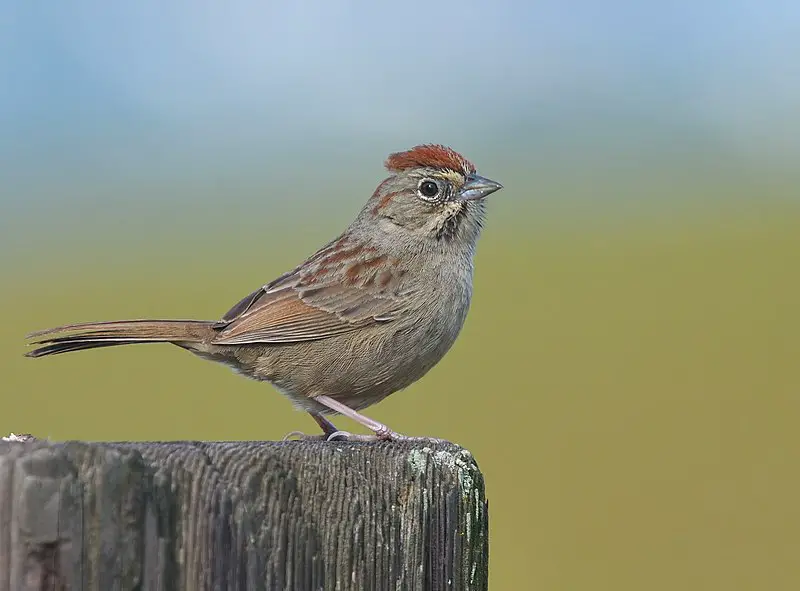
The Rufous-crowned Sparrow is a small American passerine found in the Southwestern US and much of Mexico. It has twelve subspecies, typically distinguished by their range and plumage variations.
They have greyish to olive brown upperparts with light streaking and white under parts with dark streaks or spots on their breast, belly or flanks.
The most distinguishing feature of these birds are the rusty red crowns for which they are named after.
Their diet consists mainly of seeds from grasses and weeds as well as insects during spring & summer months when raising young chicks.
These birds inhabit open woodland edges, desert scrubland, rangelands & grasslands often near water sources like rivers or creeks making it easier to find food resources needed for survival throughout its range.Scientific classification:
| Kingdom | Animalia |
| Phylum | Chordata |
| Class | Aves |
| Order | Passeriformes |
| Family | Passerellidae |
| Genus | Aimophila |
| Species | A. ruficeps |
Also Featured In: Common Birds of Mexico City,
38. Green-Tailed Towhee
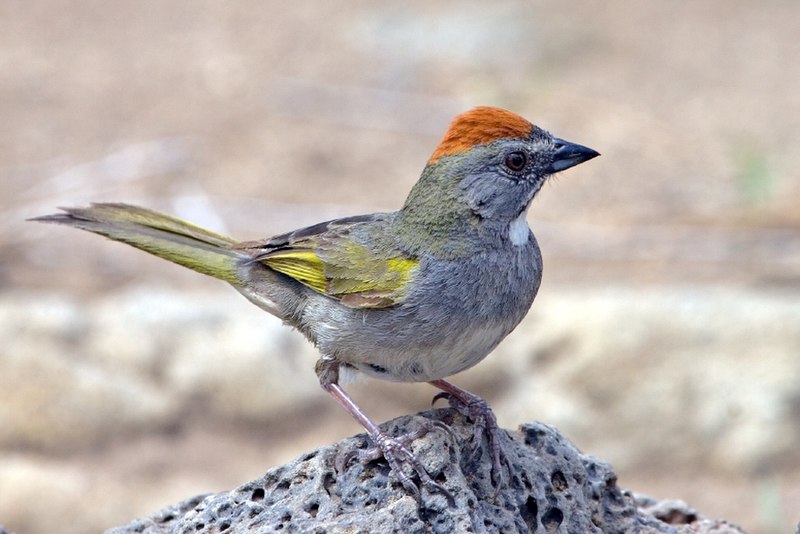
The Green-tailed Towhee is a small but impressive bird, belonging to the American sparrow family Passerellidae.
It has an extensive breeding range across much of the interior Western United States, and winters in Mexico and parts of Southwestern US.
The most noticeable feature of this towhee is its bright green stripes on the edge of each wing – what makes it stand out among other birds.
Its diet consists mostly of insects, seeds and berries which they search for on or near ground level by hopping around.
During nesting season these birds can be heard singing their melodic song from dense shrubs and trees where they build their nests with grasses, twigs and leaves lined inside with fur or feathers for insulation.Scientific classification:
| Kingdom | Animalia |
| Phylum | Chordata |
| Class | Aves |
| Order | Passeriformes |
| Family | Passerellidae |
| Genus | Pipilo |
| Species | P. chlorurus |
39. Olive Sparrow
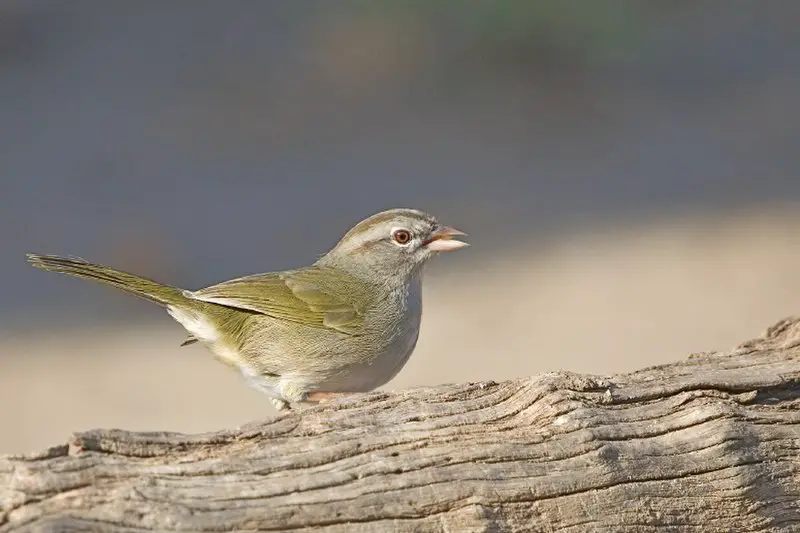
The Olive Sparrow is a species of American sparrow in the family Passerellidae. It has an olive-colored back, with white streaks on its sides and dark brown stripes above its eyes.
Its wings are also slightly darker than its body coloration. This small bird grows to be between 5.5 – 6.1 inches long and can typically be found in Belize, Costa Rica, Guatemala, Honduras Mexico Nicaragua and southern Texas (Val Verde County).
The Olive Sparrow feeds mainly on insects but will eat some seeds as well as berries when they become available during certain times of the year making them omnivores by nature.
They usually make their nests high up in trees or bushes where there’s plenty of cover from predators such as hawks or owls which may prey upon them if given the opportunity to do so.Scientific classification:
| Kingdom | Animalia |
| Phylum | Chordata |
| Class | Aves |
| Order | Passeriformes |
| Family | Passerellidae |
| Genus | Arremonops |
| Species | A. rufivirgatus |
Also Featured In: Birds You’ll Find in the Rio Grande Valley, Birds That Live around South Padre Island
40. Baird’s Sparrow

The Baird’s Sparrow is a small, migratory bird native to the United States, Canada and Mexico.
It has a yellow-brown face with subtle black markings and brown streaks on its chest that are unique among other sparrows.
Its wings are dark grayish-brown edged with white specks on the secondaries while its tail feathers have faint tan or grey barring.
The underparts of this species range from pale buffy to pinkish in coloration depending on their age and sex.
Overall it is an attractive little songbird which can be found living amongst low shrubs in open grasslands near water sources during migration season.
When not migrating these birds will usually move into drier habitats such as sagebrush steppes for nesting purposes where they build cup shaped nests lined with dried vegetation material close to ground level within plant cover such as long grasses and ditches.Scientific classification:
| Kingdom | Animalia |
| Phylum | Chordata |
| Class | Aves |
| Order | Passeriformes |
| Family | Passerellidae |
| Genus | Centronyx |
| Species | C. bairdii |
41. Botteri’s Sparrow
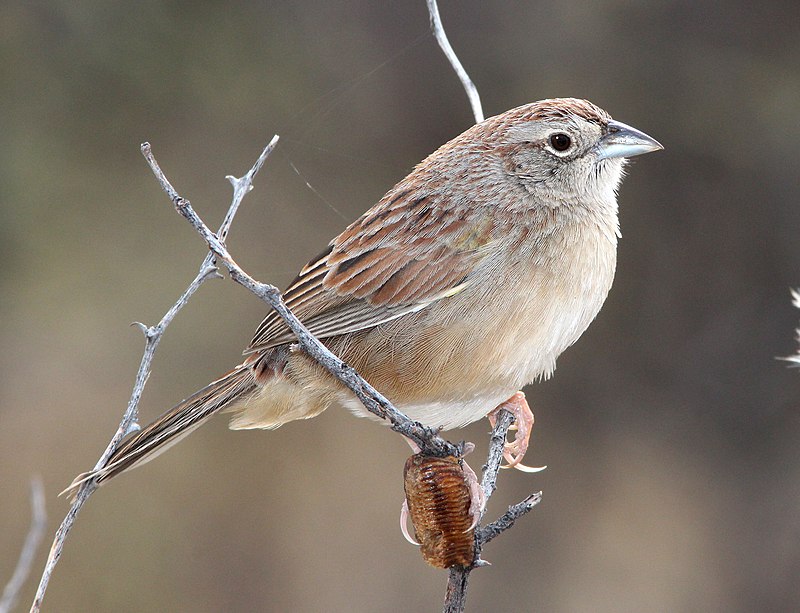
Botteri’s sparrow is a medium-sized bird found mainly in Mexico, with its breeding range extending into southeastern Arizona and southern Texas.
Despite the presence of small non-migratory populations there, this species faces threats due to habitat loss.
It was not seen in Arizona between the 1890s and mid-20th century, although some have since returned thanks to conservation efforts aiming at preserving their natural habitats.
They are mostly grayish brown birds that feature white stripes on their heads and wings, as well as whitish or pale yellow bellies which make them easily recognizable among other passerines.Scientific classification:
| Kingdom | Animalia |
| Phylum | Chordata |
| Class | Aves |
| Order | Passeriformes |
| Family | Passerellidae |
| Genus | Peucaea |
| Species | P. botterii |
42. Cassin’s Sparrow
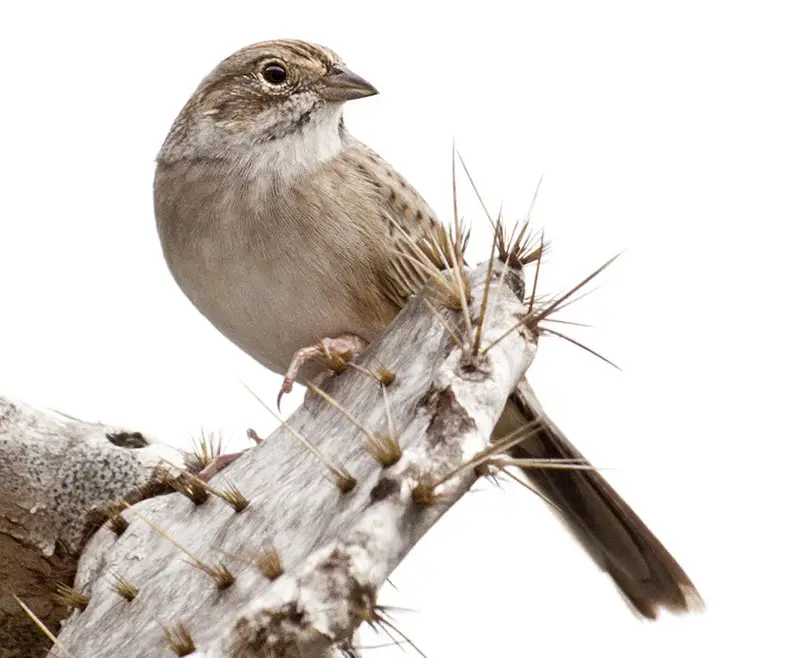
Cassin’s sparrow is a medium-sized passerine bird that inhabits the western regions of Nebraska and extends to north-central Mexico. It was originally described in 1852 by Samuel W.
Woodhouse, who gave it its species name in honor of John Cassin, an ornithologist from Philadelphia.
This sparrow is mainly brown with white streaks on its chest and belly area giving it a distinctive look amongst other birds within its range.
They usually live in grasslands or shrubby areas where they feed on seeds, insects and berries found there during different times of the year enough for them to survive.
Their song consists of several thin notes repeated rapidly which makes them stand out among others due to their unique call making them easily recognizable even if not seen directly.Scientific classification:
| Kingdom | Animalia |
| Phylum | Chordata |
| Class | Aves |
| Order | Passeriformes |
| Family | Passerellidae |
| Genus | Peucaea |
| Species | P. cassinii |
43. Chestnut-Collared Longspur
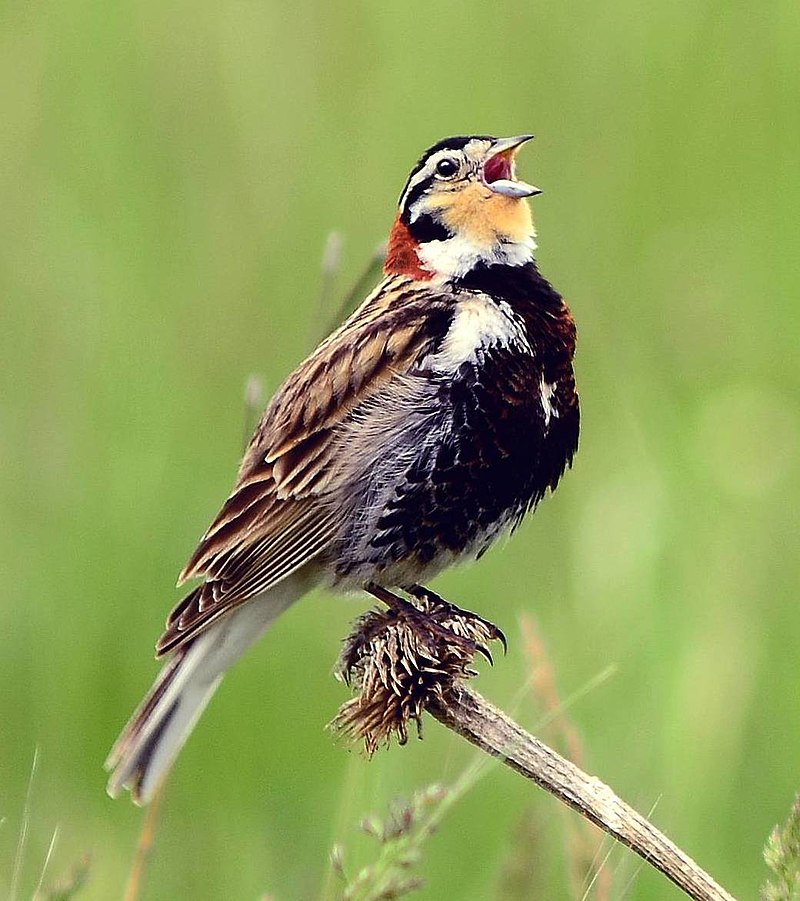
The Chestnut-collared Longspur is a small, seed-eating bird that primarily inhabits prairie habitats in Canada and the northern United States.
It has a short conical bill, a streaked back and white tail with dark markings along its edges.
During the breeding season they move northward to their nesting grounds while during winter they migrate southwards towards Mexico and parts of US where temperatures are more favourable for survival.
They form flocks when migrating or searching for food which can contain up to 50 birds at any given time.
The diet of this species consists mainly of seeds but also includes insects such as grasshoppers, beetles etc., making them an important part of the local ecosystem by controlling insect populations.
These little birds may be hard to spot due to their elusive nature but if you’re lucky enough you might spot one on your next visit outdoors.Scientific classification:
| Kingdom | Animalia |
| Phylum | Chordata |
| Class | Aves |
| Order | Passeriformes |
| Family | Calcariidae |
| Genus | Calcarius |
| Species | C. ornatus |
44. Rufous-Winged Sparrow
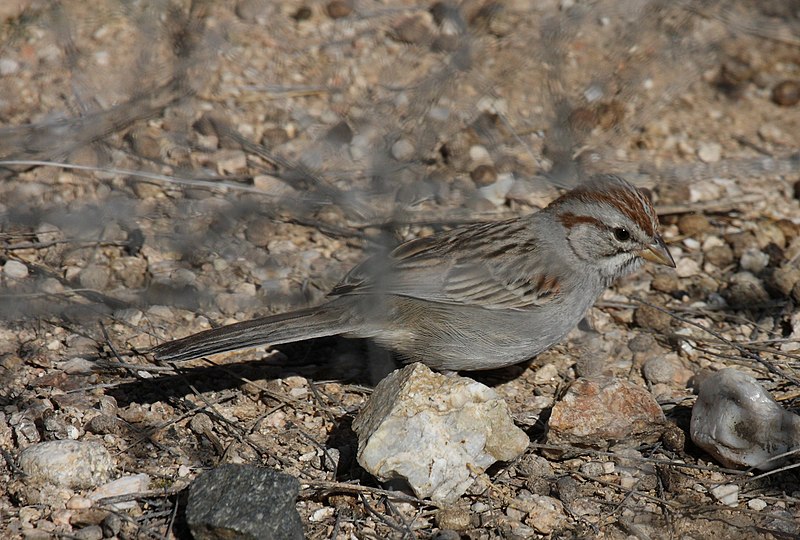
The Rufous-winged sparrow is a medium-small New World bird with an unmistakable appearance. Its face and supercilium are gray, while its crown has rusty tones.
It also sports rufous coverts on the wings that may not be visible at first glance. The back of this bird shows brown feathers streaked with darker colors, complementing its pale gray belly nicely.
A conical yellow bill completes the look as well as a long brown tail to give it some extra flair in flight. All these features make it easy to identify among other birds and makes for beautiful sight when seen up close.Scientific classification:
| Kingdom | Animalia |
| Phylum | Chordata |
| Class | Aves |
| Order | Passeriformes |
| Family | Passerellidae |
| Genus | Peucaea |
| Species | P. carpalis |
45. Striped Sparrow
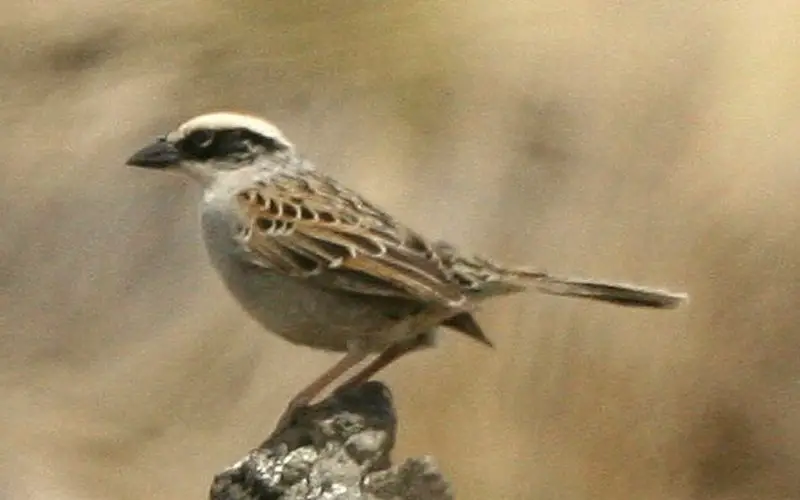
The striped sparrow is a unique species of bird found only in Mexico. It belongs to the Passerellidae family and has no known subspecies within its own genus, Oriturus.
This small but colorful bird is found mainly in subtropical or tropical montane forests as well as temperate grasslands.
Its feathers are a mixture of black and white stripes with some reddish-orange patches on their wings, making them one of the most distinct looking birds around.
Striped sparrows feed mostly on insects such as caterpillars which they catch by darting through thick foliage or hovering over short vegetation before swooping down to capture their prey.
Despite being endemic to Mexico, they can still be seen across parts of North America due to migration patterns allowing them access into other countries each year.Scientific classification:
| Kingdom | Animalia |
| Phylum | Chordata |
| Class | Aves |
| Order | Passeriformes |
| Family | Passerellidae |
| Genus | Oriturus Bonaparte, 1850 |
| Species | O. superciliosus |
46. Black-Chinned Sparrow
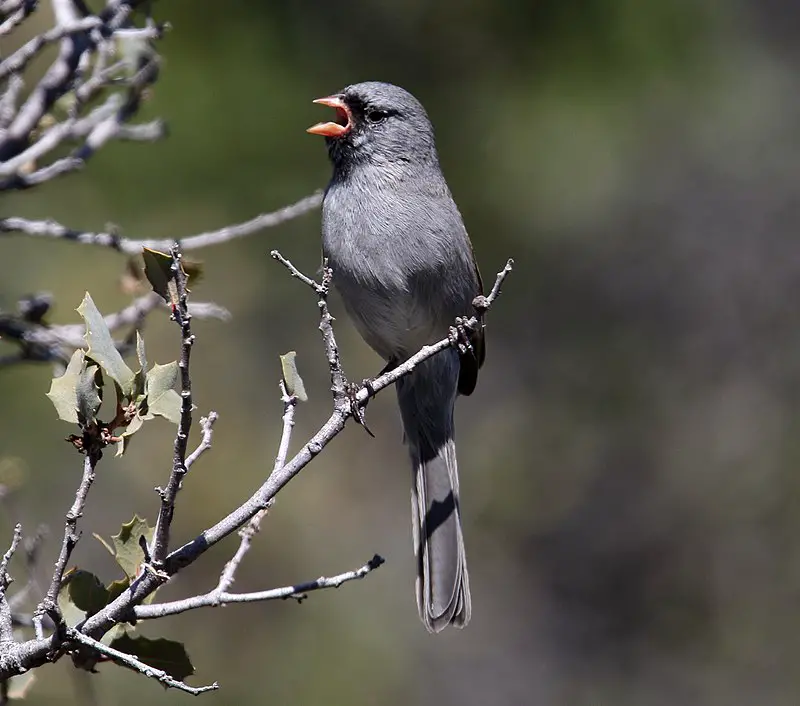
The Black-chinned Sparrow is a small, slim bird found in the southwestern United States and Mexico. It has gray plumage with reddish-brown on its wings, tail feathers, and black chin.
Its long tail helps it to maneuver quickly through dense vegetation when searching for food or seeking shelter from predators.
This species migrates south after breeding during summer months while those living in Mexico are year-round residents of their habitat.
The diet consists mainly of seeds but they will also eat insects such as grasshoppers and caterpillars as well as spiders and other invertebrates for protein rich nutrition supplementing their seed based diet.
They require open habitats like grasslands to find food sources so conservation efforts focus on providing these important habitats throughout their range.
This includes avoiding land conversion into agricultural areas which could impact them adversely if not managed properly by local authorities.Scientific classification:
| Kingdom | Animalia |
| Phylum | Chordata |
| Class | Aves |
| Order | Passeriformes |
| Family | Passerellidae |
| Genus | Spizella |
| Species | S. atrogularis |
Also Featured In: Birds that Live in Chaparral,
47. Five-Striped Sparrow
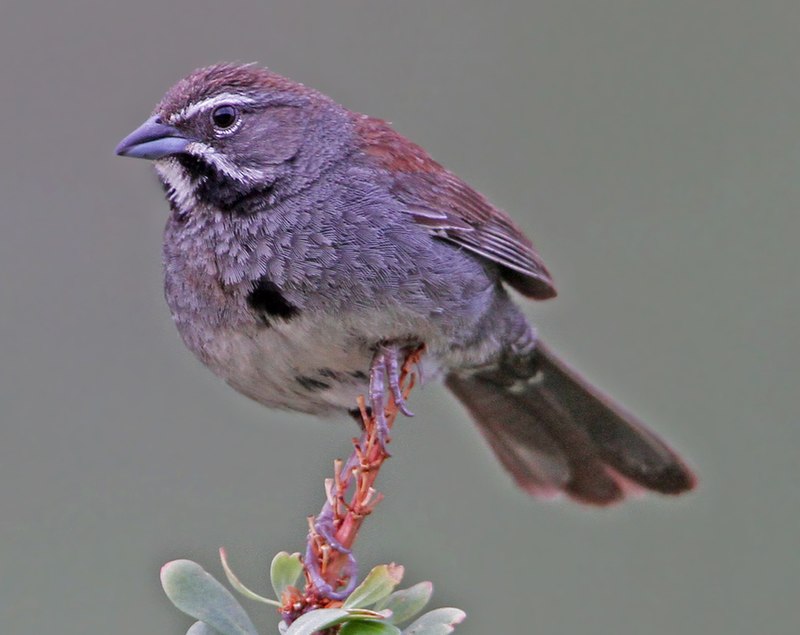
The five-striped sparrow is a medium-sized passerine bird found along the eastern Gulf of California region and Pacific region of western Mexico.
It was formerly classified in the genus Amphispiza, with the black-throated sparrow as its only member.
This species has distinctive stripes across its back and wings; these are white or tan on top, while underneath they are brownish grey.
The head is lighter in color than other parts of this species’ body and it has a thin bill that curves slightly downward at the tip.
Its diet consists mainly of insects, but it will also eat grains from nearby farms when available during breeding season.
This small but attractive bird provides an important ecological role within its habitat by helping to keep insect populations under control.Scientific classification:
| Kingdom | Animalia |
| Phylum | Chordata |
| Class | Aves |
| Order | Passeriformes |
| Family | Passerellidae |
| Genus | Amphispizopsis Wolters, 1980 |
| Species | A. quinquestriata |
48. Bell’s Sparrow
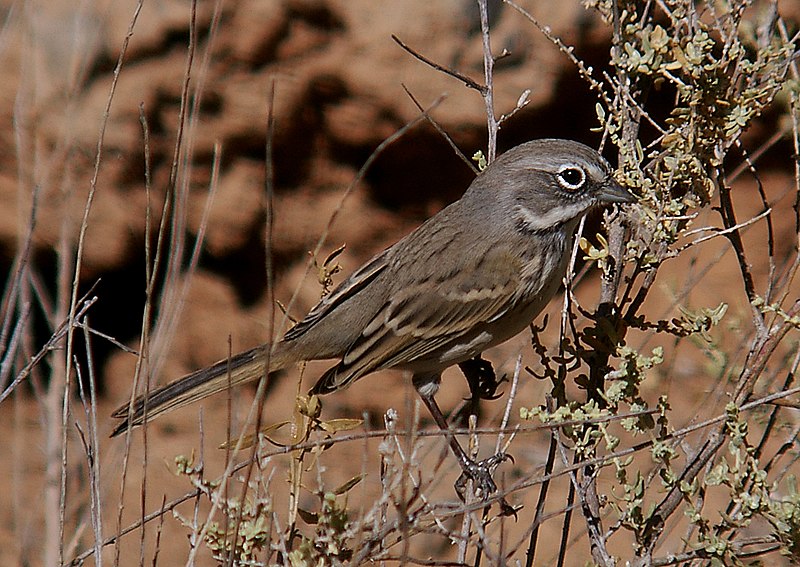
Bell’s sparrow is a medium-sized bird commonly found in the western United States and northwestern Mexico.
This species can be identified by its light buffy underparts, brownish upperparts, and distinctive facial pattern with pale eyestripe.
There are four populations of Bell’s Sparrow that inhabit the west: subspecies canescens breeds in south-central California; belli nominate subspecies lives throughout the coast ranges of California; clementeae resides on Santa Clemente Island off southern California; and australis occupies islands off northern Baja coastal region.
All have adapted to their respective local environments to cope with scarce water resources or other environmental pressures such as predators or competitors for food sources.
These birds also have different habitat preferences based on geographic location which include scrub habitats, grasslands and chaparral regions.Scientific classification:
| Kingdom | Animalia |
| Phylum | Chordata |
| Class | Aves |
| Order | Passeriformes |
| Family | Passerellidae |
| Genus | Artemisiospiza |
| Species | A. belli |
49. Desert Sparrow
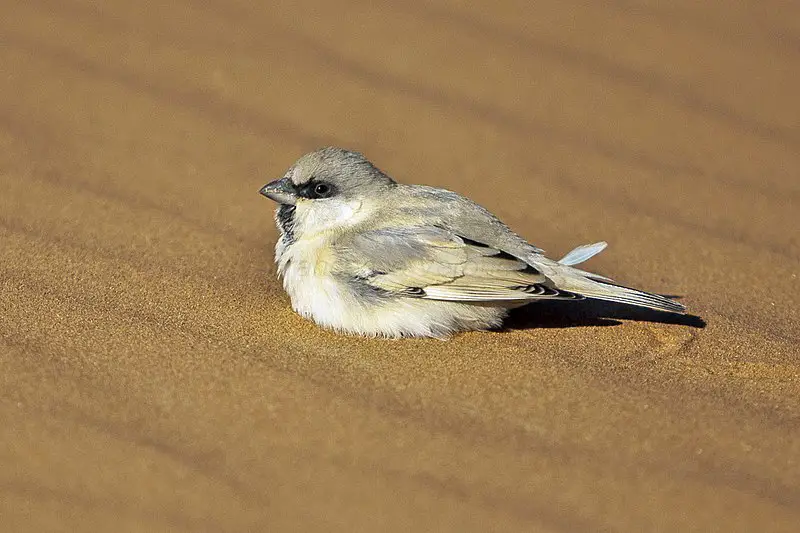
The Desert Sparrow is a small bird found in the Sahara desert of northern Africa. It belongs to the sparrow family Passeridae and has similar characteristics with Zarudny’s Sparrow, which inhabits Central Asia.
Historically, it was considered as a subspecies but later recognized as separate species by BirdLife International.
This tiny bird has grayish-brown upper parts with black streaks on its crown and center back while its underparts are whitish or yellowish buff coloration.
Its short bill is pale blue-gray above and pink below, surrounded by white feathers around eyes that gives them an attractive look.
Although not much known about their behavior yet they can be heard singing during breeding season when males sing loudly for females’ attraction.Scientific classification:
| Kingdom | Animalia |
| Phylum | Chordata |
| Class | Aves |
| Order | Passeriformes |
| Family | Passeridae |
| Genus | Passer |
| Species | P. simplex |
50. Sind Sparrow
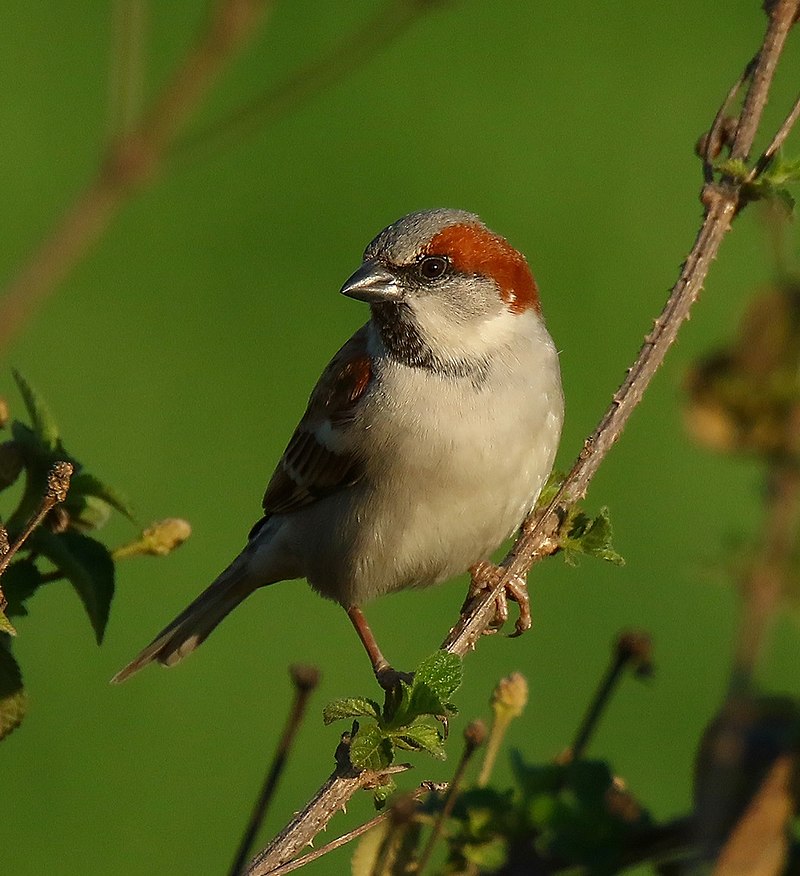
The Sind sparrow is a small passerine bird of the Passeridae family, native to South Asia. It has similar features to the house sparrow but with distinctive plumage differences; males have brighter feathers than females and young birds.
The Sind Sparrow lives in open forests, farmland and rural regions around the Indus Valley region in India, Pakistan and Afghanistan making it an important part of local wildlife.
Its diet consists mainly of vegetation such as grains or seeds along with some insects found on land or water sources like riverside pools.
Conservation efforts are needed for this species due its decreasing population size caused by habitat destruction from human activities such as deforestation and urbanization.Scientific classification:
| Kingdom | Animalia |
| Phylum | Chordata |
| Class | Aves |
| Order | Passeriformes |
| Family | Passeridae |
| Genus | Passer |
| Species | P. pyrrhonotus |
51. Italian Sparrow
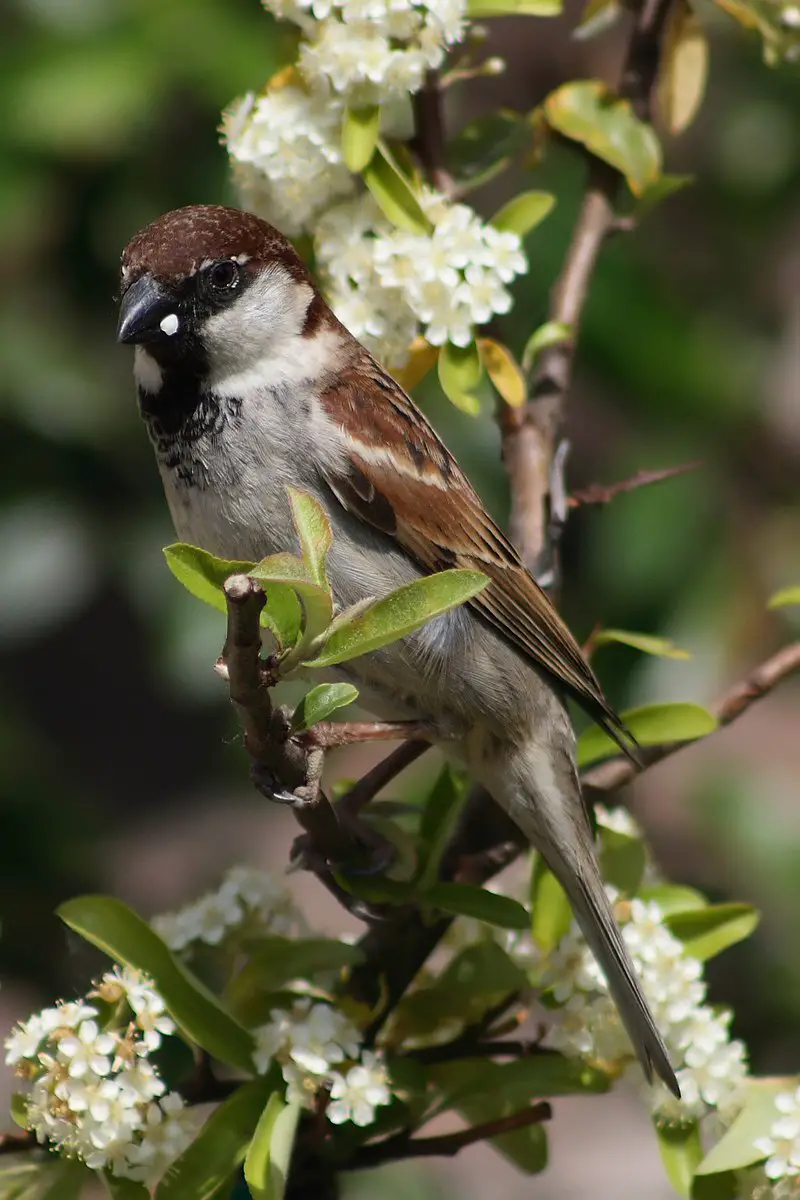
The Italian sparrow (Passer italiae) is a species of passerine bird found in Italy and other parts of the Mediterranean region.
It has an appearance that lies between the house sparrow and Spanish Sparrow, both closely related to eachother.
The head, back and wings are brown while its chest is lighter colored with some grey shading on its sides.
Its tail feathers have white edges which can be seen when flying or perching on trees. This small bird feeds mainly on insects but also eats grains such as wheat, oats and barley if available.
Breeding takes place from April until August during which time they build nests consisting of grasses lined with hair or fur for insulation inside tree cavities or buildings where four to five eggs may be laid at one time.Scientific classification:
| Kingdom | Animalia |
| Phylum | Chordata |
| Class | Aves |
| Order | Passeriformes |
| Family | Passeridae |
| Genus | Passer |
| Species | P. italiae |
Also Featured In: Italian Birds You Should Know,